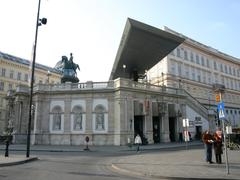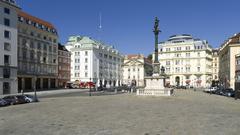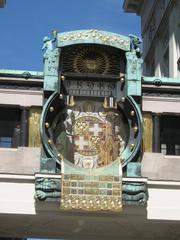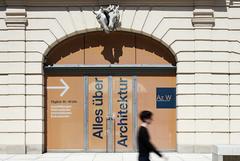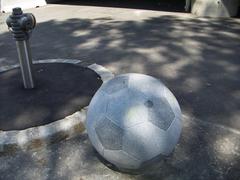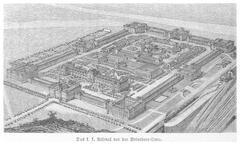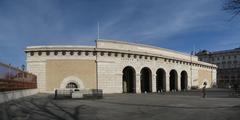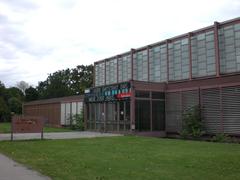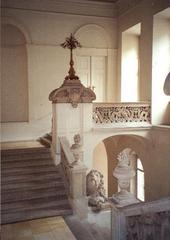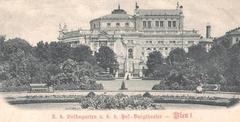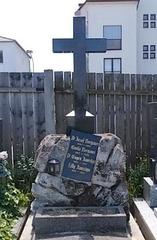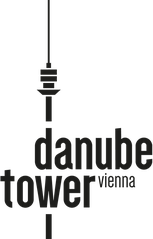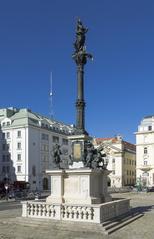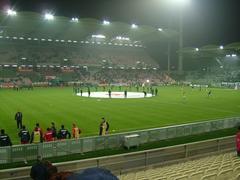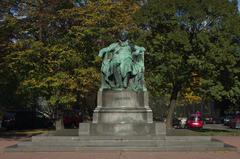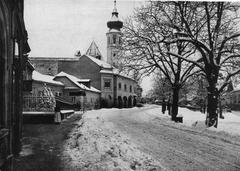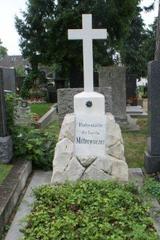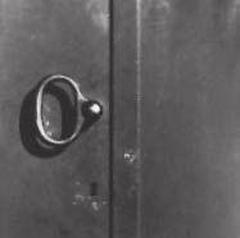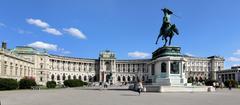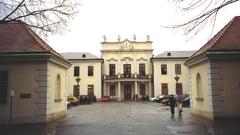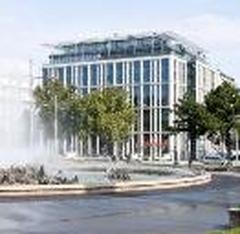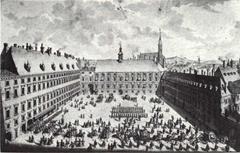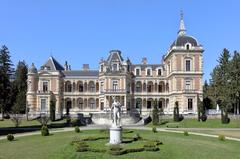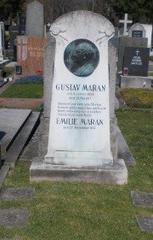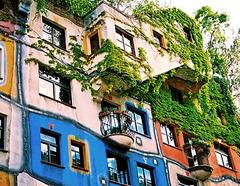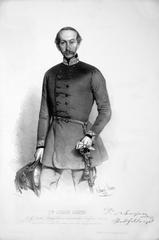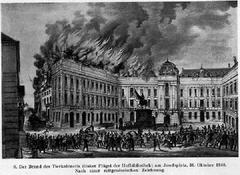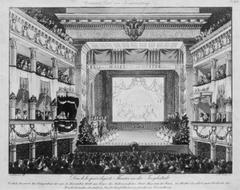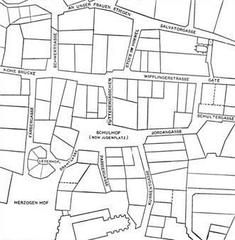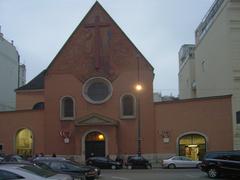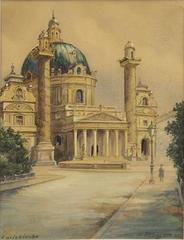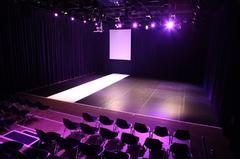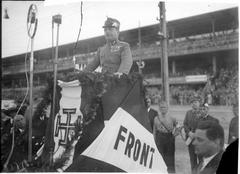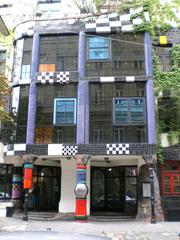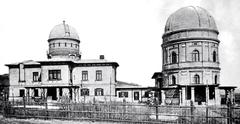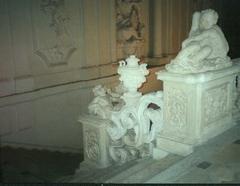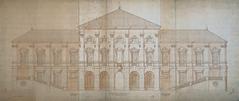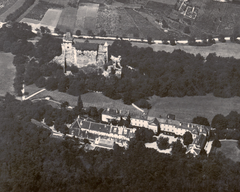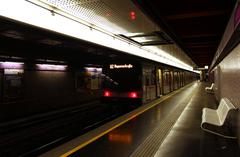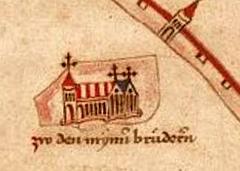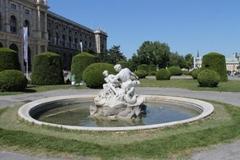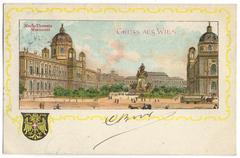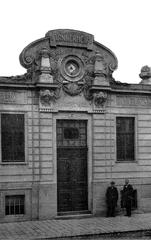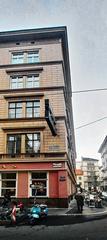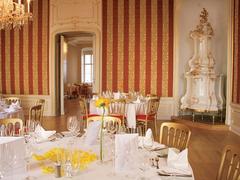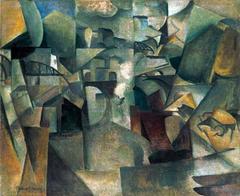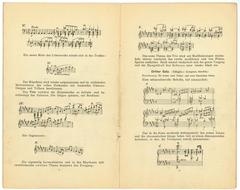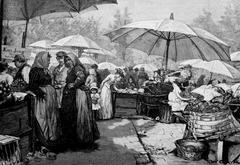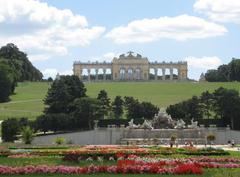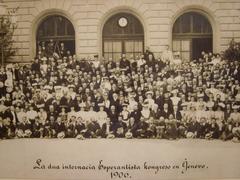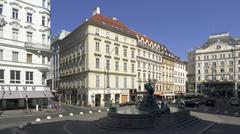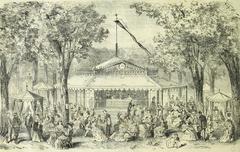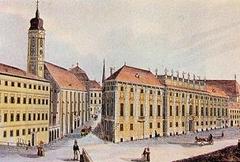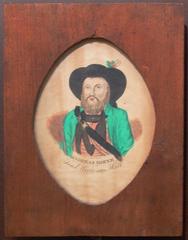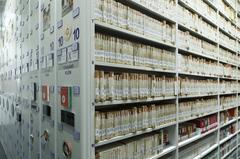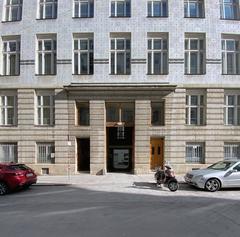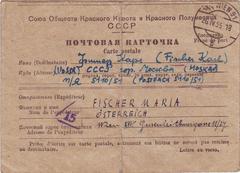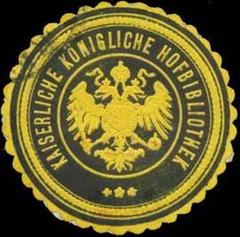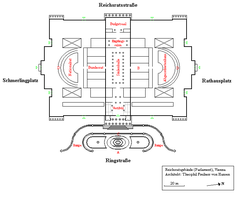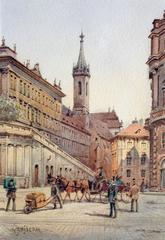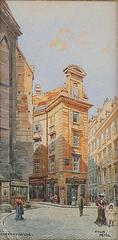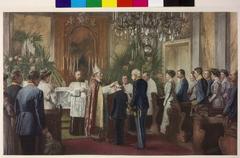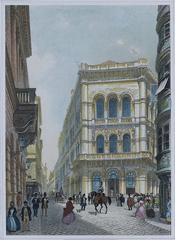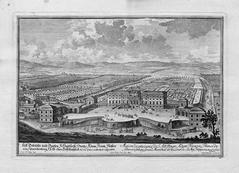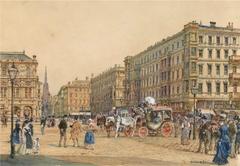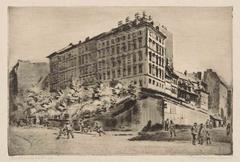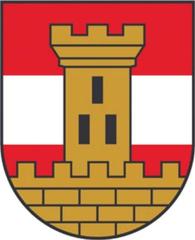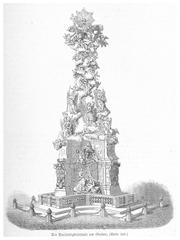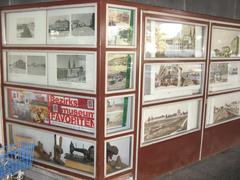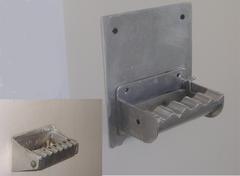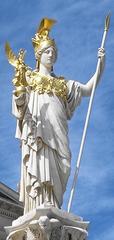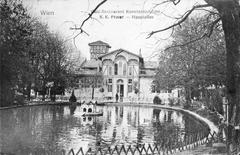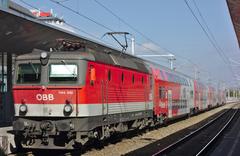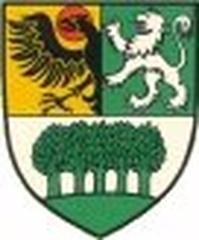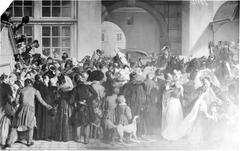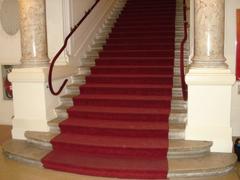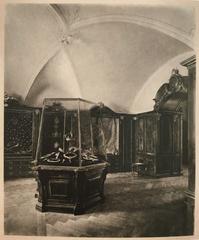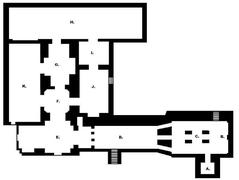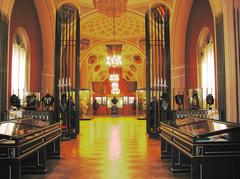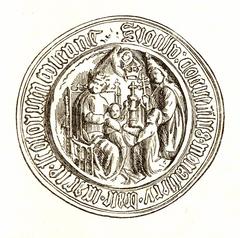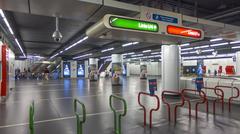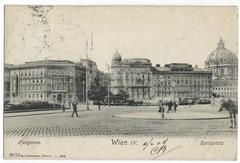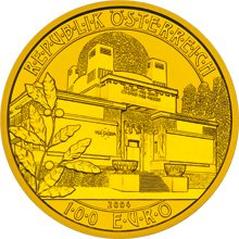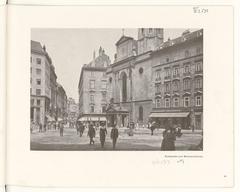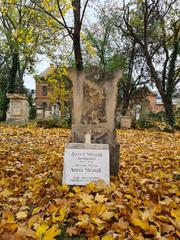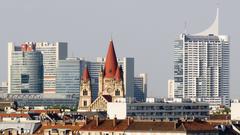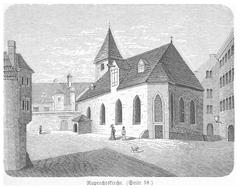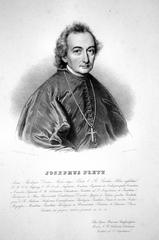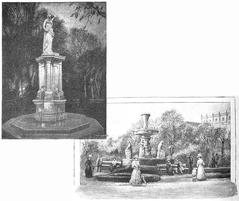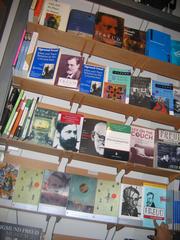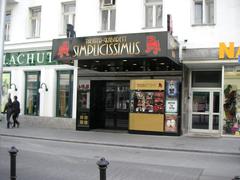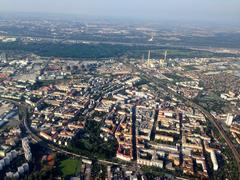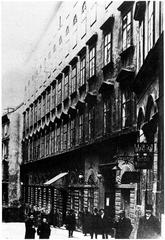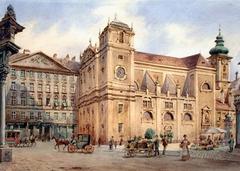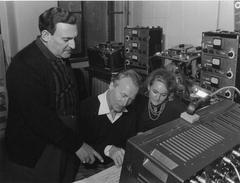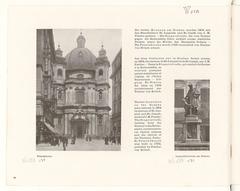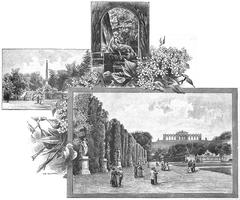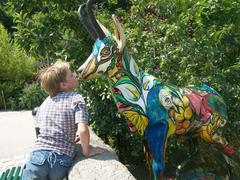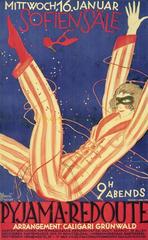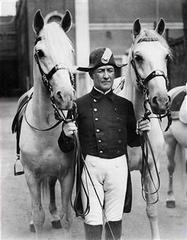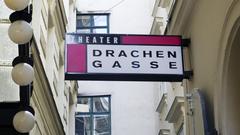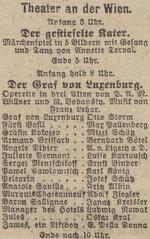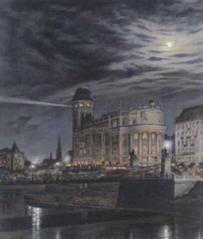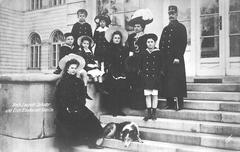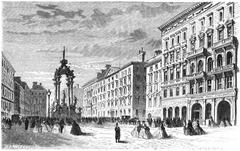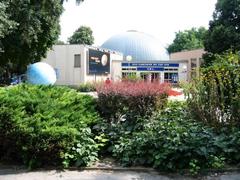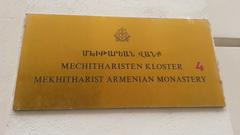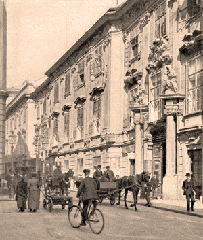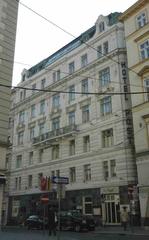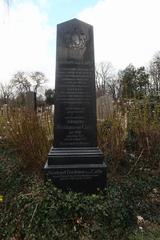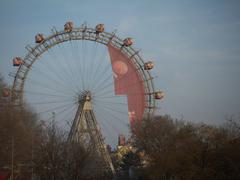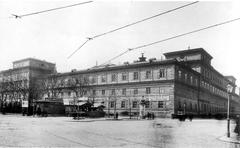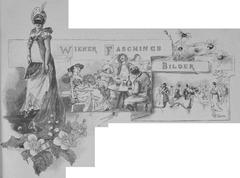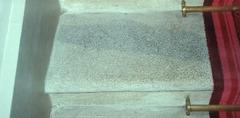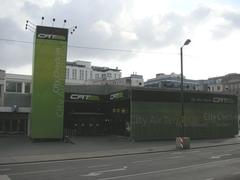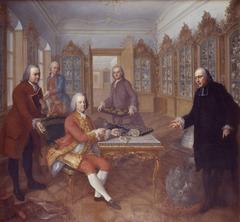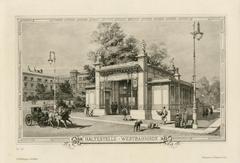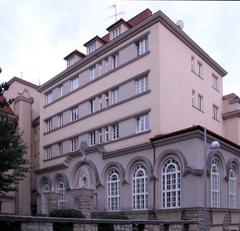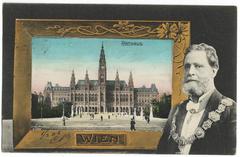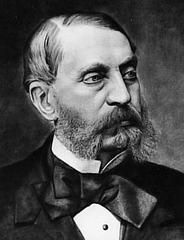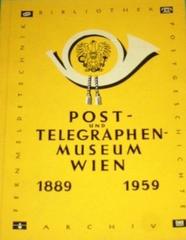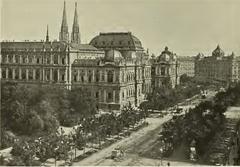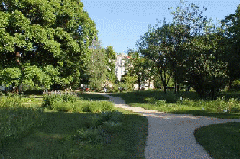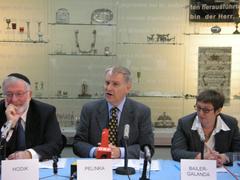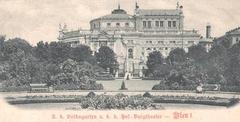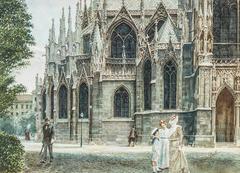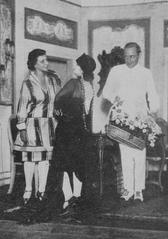वियना, ऑस्ट्रिया में इरविन श्रोडिंगर इंटरनेशनल इंस्टीट्यूट फॉर मैथमेटिक्स एंड फिजिक्स की यात्रा के लिए विस्तृत मार्गदर्शिका
दिनांक: 03/07/2025
परिचय
वियना के ऐतिहासिक 9वें जिले में स्थित इरविन श्रोडिंगर इंटरनेशनल इंस्टीट्यूट फॉर मैथमेटिक्स एंड फिजिक्स (ESI), गणित और भौतिकी में अंतःविषय अनुसंधान के लिए एक प्रमुख केंद्र है। 20वीं सदी के सबसे प्रभावशाली वैज्ञानिकों में से एक, नोबेल पुरस्कार विजेता इरविन श्रोडिंगर के नाम पर, ESI वियना की समृद्ध अकादमिक विरासत और आधुनिक वैज्ञानिक उन्नति के चौराहे पर खड़ा है। 1993 में बोलट्ज़मैनगासे 9 में एक दो-सदी पुरानी पूर्व कैथोलिक सेमिनरी में स्थापित, ESI ने एक ऐसा वातावरण तैयार किया है जहाँ परंपरा और नवाचार का मेल होता है, जो अंतर्राष्ट्रीय सहयोग और अभूतपूर्व अनुसंधान को बढ़ावा देता है। मुख्य रूप से एक अनुसंधान संस्थान होने के बावजूद, ESI कभी-कभी सार्वजनिक व्याख्यानों, कार्यशालाओं और आउटरीच कार्यक्रमों के लिए अपने दरवाजे खोलता है, जिससे वियना के वैज्ञानिक और सांस्कृतिक माहौल में एक अनूठी अंतर्दृष्टि मिलती है।
ESI का केंद्रीय स्थान सार्वजनिक परिवहन के माध्यम से सुविधाजनक पहुँच सुनिश्चित करता है, जिसमें शोटेनटोर और अल्सर स्ट्रास जैसे पास के यू-बान स्टेशन हैं। सिगमंड फ्रायड संग्रहालय और वियना विश्वविद्यालय जैसे सांस्कृतिक स्थलों से इसकी निकटता इसे वियना के अकादमिक और ऐतिहासिक परिदृश्य में रुचि रखने वालों के लिए एक आदर्श पड़ाव बनाती है। यद्यपि संस्थान के पास नियमित सार्वजनिक दर्शनीय घंटे या टिकटिंग प्रणाली नहीं है, संभावित आगंतुक ESI की आधिकारिक वेबसाइट पर अद्यतन कार्यक्रम अनुसूची और कभी-कभी निर्देशित पर्यटन के बारे में जानकारी पा सकते हैं। संस्थान सुगम्यता के लिए प्रतिबद्ध है और गतिशीलता आवश्यकताओं वाले आगंतुकों के लिए अग्रिम व्यवस्था प्रदान करता है।
यह विस्तृत मार्गदर्शिका आपको ESI के इतिहास, महत्व, आगंतुक प्रक्रियाओं, सुविधाओं, आस-पास के आकर्षणों और व्यावहारिक युक्तियों का विवरण देकर ESI की आपकी यात्रा की योजना बनाने में मदद करेगी। चाहे आप सहयोग चाहने वाले वैज्ञानिक हों या वियना की बौद्धिक विरासत के बारे में उत्सुक यात्री, ESI गणित और भौतिकी के क्षेत्र में अग्रणी और इरविन श्रोडिंगर की स्थायी विरासत के साथ जुड़ने का एक विशिष्ट अवसर प्रदान करता है।
सामग्री तालिका
- अवलोकन
- स्थान और सुगम्यता
- दर्शनीय घंटे और प्रवेश
- सुविधाएँ और आगंतुक अनुभव
- ऐतिहासिक महत्व
- आस-पास के आकर्षण
- व्यावहारिक सुझाव
- अक्सर पूछे जाने वाले प्रश्न (FAQ)
- ESI का मिशन और गतिविधियाँ
- भागीदारी और कार्यक्रम
- स्वास्थ्य और सुरक्षा
- ESI अनुभव की अनूठी विशेषताएँ
- उल्लेखनीय वार्षिक कार्यक्रम
- डिजिटल जुड़ाव
- आवश्यक संपर्क और संसाधन
- सारांश और अंतिम सुझाव
- संदर्भ
अवलोकन
इरविन श्रोडिंगर इंटरनेशनल इंस्टीट्यूट फॉर मैथमेटिक्स एंड फिजिक्स (ESI) बोलट्ज़मैनगासे 9, 1090 वियना में एक अंतरराष्ट्रीय स्तर पर प्रशंसित अनुसंधान केंद्र है। यह उच्चतम स्तर पर सहयोग को बढ़ावा देने और वियना के अकादमिक और सांस्कृतिक पारिस्थितिकी तंत्र में अपनी अनूठी भूमिका के लिए प्रसिद्ध है।
स्थान और सुगम्यता
पता: बोलट्ज़मैनगासे 9, 1090 वियना, ऑस्ट्रिया
- सार्वजनिक परिवहन: वियना के यू-बान (अंडरग्राउंड) और ट्राम नेटवर्क के माध्यम से आसानी से पहुँचा जा सकता है। निकटतम स्टेशन शोटेनटोर (U2) और अल्सर स्ट्रास (U6) हैं, जिनमें कई ट्राम और बस स्टॉप पास में हैं (वियना सार्वजनिक परिवहन)।
- हवाई अड्डा पहुँच: वियना अंतर्राष्ट्रीय हवाई अड्डा (VIE) लगभग 16 मिनट में सिटी एयरपोर्ट ट्रेन (CAT) द्वारा शहर के केंद्र से जुड़ा हुआ है (क्रिएटिव ट्रैवल गाइड)।
- सुगम्यता: संस्थान व्हीलचेयर सुलभ है। विशेष व्यवस्था की आवश्यकता वाले आगंतुकों को अग्रिम रूप से ESI प्रशासन से संपर्क करना चाहिए।
दर्शनीय घंटे और प्रवेश
- खुलने का समय: सोमवार से शुक्रवार, सुबह 9:00 बजे – शाम 6:00 बजे। शाम, सप्ताहांत और सार्वजनिक छुट्टियों के दौरान प्रवेश द्वार आम तौर पर बंद रहता है; मानक घंटों के बाहर पहुँच के लिए अग्रिम व्यवस्था की आवश्यकता होती है।
- सार्वजनिक प्रवेश: ESI सार्वजनिक टिकटिंग प्रणाली का संचालन नहीं करता है। यात्राएँ मुख्य रूप से आमंत्रण द्वारा होती हैं, लेकिन सार्वजनिक व्याख्यान, चयनित कार्यशालाएँ और विशेष कार्यक्रम कभी-कभी व्यापक दर्शकों के लिए खुले होते हैं। कार्यक्रम अनुसूची और आगंतुक जानकारी नियमित रूप से ESI वेबसाइट पर पोस्ट की जाती है।
- पंजीकरण: आमंत्रित मेहमानों को आवास या यात्रा आवश्यकताओं के लिए व्यक्तिगत पंजीकरण लिंक और सहायता प्राप्त होती है (ESI अतिथियों के लिए जानकारी)।
सुविधाएँ और आगंतुक अनुभव
- अनुसंधान और सेमिनार स्थान: ESI एक ऐतिहासिक भवन में आधुनिक सेमिनार कक्ष, बोलट्ज़मैन लेक्चर हॉल और सहयोगात्मक कार्यालय प्रदान करता है (ESI वार्षिक रिपोर्ट 2021, पृ. 98)।
- पुस्तकालय पहुँच: आगंतुक अनुरोध पर वियना विश्वविद्यालय के गणित और भौतिकी पुस्तकालयों का उपयोग कर सकते हैं।
- भोजन: कई वियनीज़ और अंतर्राष्ट्रीय रेस्तरां पैदल दूरी पर हैं। प्रशासन कार्यालय सिफारिशें प्रदान कर सकता है।
- फोटोग्राफिक अवसर: आगंतुकों के लिए भवन का ऐतिहासिक और अकादमिक माहौल उत्कृष्ट फोटोग्राफी स्थल प्रदान करता है।
ऐतिहासिक महत्व
स्थापना और विजन
1993 में स्थापित, ESI को गणित और भौतिकी के बीच, साथ ही विभिन्न देशों के वैज्ञानिकों के बीच एक पुल के रूप में परिकल्पित किया गया था—विशेषकर यूरोप में राजनीतिक परिवर्तन के समय (ESI वार्षिक रिपोर्ट 2021, पृ. 2)। यह अंतर्राष्ट्रीय सहयोग और बौद्धिक आदान-प्रदान को बढ़ावा देकर इरविन श्रोडिंगर की विरासत का सम्मान करता है।
विकास और वैश्विक प्रभाव
अपनी स्थापना के बाद से, ESI एक विश्व स्तरीय संस्थान के रूप में विकसित हुआ है, जो सालाना सैकड़ों शोधकर्ताओं की मेजबानी करता है और प्रमुख वैज्ञानिक कार्यक्रमों का आयोजन करता है। 2011 से, ESI वियना विश्वविद्यालय से संबद्ध है, जो इसके अकादमिक आउटरीच को और मजबूत करता है।
आस-पास के आकर्षण
सांस्कृतिक रूप से समृद्ध अल्सरग्रंड जिले में स्थित, ESI इनके करीब है:
- सिगमंड फ्रायड संग्रहालय
- वियना विश्वविद्यालय
- ऑस्ट्रियाई राष्ट्रीय पुस्तकालय
- वियना का ऐतिहासिक केंद्र (यूनेस्को विश्व धरोहर स्थल)
- वियना स्टेट ओपेरा, म्यूजियमक्वार्टियर, हॉफबर्ग पैलेस
- पारंपरिक वियनीज़ कॉफ़ी हाउस
अधिक दर्शनीय स्थलों के विचारों के लिए, वियना की आधिकारिक पर्यटक साइट पर जाएं।
व्यावहारिक सुझाव
- यात्रा का सबसे अच्छा समय: सार्वजनिक कार्यक्रमों और व्याख्यानों के लिए ESI वेबसाइट पर नज़र रखें।
- अग्रिम योजना: अधिकांश भागीदारी आमंत्रण द्वारा होती है; यदि आप अनुसूचित सार्वजनिक कार्यक्रमों में रुचि रखते हैं तो प्रशासन से संपर्क करें।
- आवास: ARCOTEL बोलट्ज़मैन वियना और कई अन्य होटल पास में हैं (ESF सम्मेलन स्थल)।
- परिवहन: वियना सार्वजनिक परिवहन पास खरीदने पर विचार करें।
- भाषा: जर्मन आधिकारिक है, लेकिन अंग्रेजी ESI और वियना के अकादमिक हलकों में व्यापक रूप से बोली जाती है।
- सुरक्षा: वियना बहुत सुरक्षित है; मानक सावधानियां पर्याप्त हैं (द वियना ब्लॉग)।
- टिपिंग: रेस्तरां और कैफे में 5-10% प्रथागत है।
अक्सर पूछे जाने वाले प्रश्न (FAQ)
प्र: क्या मैं आमंत्रण के बिना ESI का दौरा कर सकता हूँ? उ: सामान्य सार्वजनिक यात्राएँ उपलब्ध नहीं हैं। हालाँकि, कुछ व्याख्यान और कार्यक्रम ESI वेबसाइट पर घोषित होने के अनुसार जनता के लिए खुले हैं।
प्र: क्या प्रवेश शुल्क हैं? उ: अधिकांश वैज्ञानिक कार्यक्रम और व्याख्यान मुफ्त हैं; कुछ के लिए अग्रिम पंजीकरण की आवश्यकता हो सकती है।
प्र: क्या संस्थान व्हीलचेयर सुलभ है? उ: हाँ। विशेष आवश्यकताओं के लिए ESI से अग्रिम रूप से संपर्क करें।
प्र: सार्वजनिक परिवहन द्वारा ESI कैसे पहुँचें? उ: शोटेनटोर (U2) या अल्सर स्ट्रास (U6) के लिए U2 लाइन के माध्यम से, साथ ही ट्राम और बस कनेक्शन।
प्र: क्या निर्देशित पर्यटन या प्रदर्शनियाँ उपलब्ध हैं? उ: निर्देशित पर्यटन नियमित रूप से पेश नहीं किए जाते हैं, लेकिन विशेष कार्यक्रमों के लिए व्यवस्था की जा सकती है।
ESI का मिशन और गतिविधियाँ
ESI गणित और भौतिकी के बीच परस्पर क्रिया पर ध्यान केंद्रित करते हुए, अंतर्राष्ट्रीय और अंतःविषय अनुसंधान को बढ़ावा देता है (ESI वार्षिक रिपोर्ट 2021, पृ. 2)। संस्थान के मुख्य उद्देश्यों में शामिल हैं:
- वैज्ञानिक आदान-प्रदान को बढ़ावा देना: विषयगत कार्यक्रम, कार्यशालाएँ और फैलोशिप आयोजित करना।
- प्रारंभिक-कैरियर शोधकर्ताओं का समर्थन करना: स्नातक स्कूलों और विशेष सेमिनारों के माध्यम से।
- वियना विश्वविद्यालय के साथ एकीकरण: संसाधनों और मार्गदर्शन तक पहुँच बढ़ाना (वियना विश्वविद्यालय गणित संकाय)।
भागीदारी और कार्यक्रम
- विषयगत कार्यक्रम: प्रति वर्ष चार से छह, आमंत्रण द्वारा (ESI गतिविधियाँ)।
- कार्यशालाएँ और उन्नत व्याख्यान: अंतर्राष्ट्रीय विशेषज्ञों को आकर्षित करने वाले सामयिक कार्यक्रम (ESI वार्षिक रिपोर्ट 2020, पृ. 46)।
- सार्वजनिक व्याख्यान: इरविन श्रोडिंगर व्याख्यान और मेडल पुरस्कार समारोह जैसे कभी-कभी होने वाले कार्यक्रम (ESI समाचार)।
- ग्रीष्मकालीन स्कूल: छात्रों और उभरते शोधकर्ताओं के लिए (ISAPP स्कूल)।
स्वास्थ्य और सुरक्षा
- COVID-19 प्रोटोकॉल: जुलाई 2025 तक, ESI के अंदर FFP2 मास्क अनिवार्य नहीं हैं, लेकिन अस्वस्थ महसूस करने वालों के लिए अनुशंसित हैं। सार्वजनिक परिवहन और चिकित्सा सुविधाओं पर मास्क अनिवार्य रहते हैं (ऑस्ट्रिया कोरोनावायरस जानकारी)।
ESI अनुभव की अनूठी विशेषताएँ
- अंतःविषय सहयोग: ESI गणित और भौतिकी के मिलन बिंदु पर सफलताओं के लिए एक उत्प्रेरक है (विकिपीडिया)।
- ऐतिहासिक सेटिंग: पूर्व सेमिनरी भवन परंपरा को आधुनिक अनुसंधान बुनियादी ढांचे के साथ जोड़ता है।
- अंतर्राष्ट्रीय समुदाय: दुनिया भर के शोधकर्ताओं का स्वागत करता है।
- वियना के अकादमिक जीवन के साथ एकीकरण: वियना विश्वविद्यालय और सांस्कृतिक संस्थानों के साथ घनिष्ठ संबंध।
उल्लेखनीय वार्षिक कार्यक्रम
- ESI मेडल पुरस्कार समारोह: गणित और भौतिकी में उत्कृष्ट उपलब्धियों को पहचानता है (ESI मेडल)।
- इरविन श्रोडिंगर व्याख्यान: प्रमुख वैज्ञानिकों द्वारा वार्ता प्रस्तुत करता है।
डिजिटल जुड़ाव
- हाइब्रिड और ऑनलाइन भागीदारी: ESI वैश्विक जुड़ाव को बढ़ावा देने वाले अपने कार्यक्रमों में डिजिटल तत्वों को शामिल करता है (ESI वार्षिक रिपोर्ट 2020, पृ. 2)।
- दृश्य संसाधन: आधिकारिक चित्र और वीडियो ESI वेबसाइट पर उपलब्ध हैं।
आवश्यक संपर्क और संसाधन
- ESI प्रशासन कार्यालय: आगंतुक सहायता और पूछताछ के लिए।
- आधिकारिक ESI वेबसाइट: https://www.esi.ac.at/info-for-guests
- वियना सार्वजनिक परिवहन: https://www.wienerlinien.at
- वियना आगंतुक सूचना: https://www.wien.info/en
- ऑडियोला ऐप निर्देशित पर्यटन के लिए: https://www.audiala.com
सारांश और अंतिम सुझाव
इरविन श्रोडिंगर इंटरनेशनल इंस्टीट्यूट फॉर मैथमेटिक्स एंड फिजिक्स वियना में वैज्ञानिक उत्कृष्टता, ऐतिहासिक महत्व और सांस्कृतिक एकीकरण का एक प्रतीक है। यद्यपि इसका प्राथमिक ध्यान अनुसंधान और विद्वत्तापूर्ण आदान-प्रदान पर है, ESI विशेष कार्यक्रमों के माध्यम से समाज तक अपनी पहुँच बढ़ाता है, जिससे विज्ञान और समाज के बीच संवाद में योगदान होता है। इसके सुलभ स्थान, स्वागत योग्य वातावरण और वियना के सांस्कृतिक स्थलों से निकटता इसे शिक्षाविदों और जिज्ञासु यात्रियों दोनों के लिए एक अनूठा गंतव्य बनाती है।
आगामी कार्यक्रमों, आगंतुक दिशानिर्देशों और भाग लेने के अवसरों के लिए ESI वेबसाइट से परामर्श करके अपनी यात्रा की योजना बनाएं। उन्नत अन्वेषण के लिए, वियना के वैज्ञानिक और ऐतिहासिक स्थलों के निर्देशित पर्यटन के लिए ऑडियाला ऐप डाउनलोड करें।
संदर्भ
- ESI आधिकारिक वेबसाइट
- ESI वार्षिक रिपोर्ट 2021
- ESI अतिथियों के लिए जानकारी
- ESI गतिविधियाँ और कार्यक्रम
- वियना सार्वजनिक परिवहन
- वियना आगंतुक सूचना
- ISAPP ग्रीष्मकालीन स्कूल ऑन ग्रेविटेशनल वेव्स
- ESI वार्षिक रिपोर्ट 2020
- द वियना ब्लॉग: वियना की यात्रा के लिए व्यावहारिक सुझाव
- विकिपीडिया: ESI
- ऑस्ट्रिया कोरोनावायरस जानकारी
- ऑडियोला ऐप
ऑडिएला2024{‘date’: ‘03/07/2025’, ‘task’: {‘model’: ‘gpt-4.1-mini’, ‘query’: ‘Comprehensive guide to visiting Erwin Schrödinger International Institute For Mathematics And Physics, Vienna, Austria: history, significance, visitor tips, and everything tourists need to know for a memorable experience.’, ‘verbose’: False, ‘guidelines’: [“Keyword Research: Identify relevant keywords that potential visitors are likely to search for, such as ‘[Monument Name] visiting hours,’ ‘[Monument Name] tickets,’ and ‘[City] historical sites.’ Use these keywords strategically throughout the article, including in the title, headers, and body text, but avoid keyword stuffing.”, ‘Engaging and Informative Title: Craft a title that is both SEO-friendly and compelling to encourage clicks. Include the main keyword and make it clear what the article will cover.’, ‘Structured Content: Use headings (H1, H2, H3) to organize the content effectively. This helps with SEO and makes the article easier for readers to navigate. Include an introduction that hooks the reader, a detailed body that covers all relevant aspects, and a conclusion that summarizes the key points.’, ‘Comprehensive Coverage: Address common questions and topics of interest such as the history of the monument, its cultural significance, visitor information (e.g., ticket prices, opening hours), travel tips, nearby attractions, and accessibility. Include sections that might be unique to the monument, like special events, guided tours, and photographic spots.’, ‘Quality Content: Ensure the content is well-researched, accurate, and provides real value to readers. Use reliable sources and provide factual information. Write in a clear, engaging, and accessible style. Consider your audience and use language that is appropriate for those likely to visit the monument.’, ‘Visuals and Media: Incorporate high-quality images or videos of the monument. These should be optimized for the web (correct sizing, alt tags with keywords). Consider interactive elements like virtual tours or maps.’, ‘Internal and External Links: Include links to other related articles on your site to encourage deeper engagement (internal links). Link to official websites for the monument or credible sources for further reading (external links).’, ‘FAQ: Incorporate FAQ sections to target voice search queries and featured snippets’, ‘Visit and Stay Up to Date: End the article with a call to action, such as encouraging readers to download our mobile app Audiala, check out other related posts, or follow on social media for more updates.’], ‘max_sections’: 4, ‘publish_formats’: {‘pdf’: False, ‘docx’: False, ‘markdown’: True}, ‘follow_guidelines’: True}, ‘title’: ‘Comprehensive Guide to Visiting the Erwin Schrödinger International Institute for Mathematics and Physics, Vienna, Austria’, ‘report’: ’# Erwin Schrödinger International Institute for Mathematics and Physics, Vienna: Visiting Hours, Tickets & Visitor Information\n\n#### Date: 03/07/2025\n\n## Introduction\n\nThe Erwin Schrödinger International Institute for Mathematics and Physics (ESI), located in Vienna’s historic 9th district, is a leading hub for interdisciplinary research in mathematics and physics. Named after Nobel laureate Erwin Schrödinger—one of the most influential scientists of the 20th century—ESI stands at the intersection of Vienna’s rich academic heritage and modern scientific advancement. Founded in 1993 in a two-century-old former Catholic seminary at Boltzmanngasse 9, ESI has cultivated an environment where tradition and innovation merge, fostering international collaboration and breakthrough research. While primarily a research institute, ESI occasionally opens its doors to the public for lectures, workshops, and outreach events, offering unique insight into Vienna’s scientific and cultural milieu.\n\nESI’s central location ensures convenient access via public transportation, with nearby U-Bahn stations such as Schottentor and Alser Straße. Its proximity to cultural sites like the Sigmund Freud Museum and the University of Vienna makes it an ideal stop for those interested in Vienna’s academic and historical landscape. Although the institute does not maintain regular public visiting hours or a ticketing system, prospective visitors can find updated event schedules and information about occasional guided tours on the official ESI website. The institute is committed to accessibility and provides advance arrangements for visitors with mobility needs.\n\nThis comprehensive guide will help you plan your visit to ESI by detailing its history, significance, visitor procedures, facilities, nearby attractions, and practical tips. Whether you are a scientist seeking collaboration or a traveler curious about Vienna’s intellectual legacy, ESI offers a distinct opportunity to engage with the forefront of mathematics and physics and the enduring legacy of Erwin Schrödinger.\n\n---\n\n## Table of Contents\n\n- Overview\n- Location and Accessibility\n- Visiting Hours & Admission\n- Facilities & Visitor Experience\n- Historical Significance\n - Founding and Vision\n - Growth and Global Impact\n- Nearby Attractions\n- Practical Tips\n- FAQs\n- ESI’s Mission and Activities\n- Participation and Events\n- Health and Safety\n- Unique Features\n- Annual Events\n- Digital Engagement\n- Visual Resources\n- Essential Contacts\n- Summary & Final Tips\n- References\n\n---\n\n## Overview\n\nThe Erwin Schrödinger International Institute for Mathematics and Physics (ESI) is an internationally acclaimed research center at Boltzmanngasse 9, 1090 Vienna. It is renowned for fostering collaboration at the highest level and for its unique role in Vienna’s academic and cultural ecosystem.\n\n---\n\n## Location and Accessibility\n\nAddress: Boltzmanngasse 9, 1090 Vienna, Austria\n\n- Public Transport: Easily accessed via Vienna’s U-Bahn (underground) and tram networks. The closest stations are Schottentor (U2) and Alser Straße (U6), with several tram and bus stops nearby (Vienna Public Transport).\n- Airport Access: Vienna International Airport (VIE) is connected to the city center by the City Airport Train (CAT) in about 16 minutes (Creative Travel Guide).\n- Accessibility: The institute is wheelchair accessible. Visitors needing special arrangements should contact the ESI administration in advance.\n\n---\n\n## Visiting Hours & Admission\n\n- Opening Hours: Monday to Friday, 9:00 a.m. – 6:00 p.m. The entrance is typically locked during evenings, weekends, and public holidays; access outside standard hours requires prior arrangement.\n- Public Access: ESI does not operate a public ticketing system. Visits are mainly by invitation, but public lectures, select workshops, and special events are occasionally open to wider audiences. Event schedules and visitor information are regularly posted on the ESI website.\n- Registration: Invited guests receive personalized registration links and support for accommodation or travel needs (ESI info for guests).\n\n---\n\n## Facilities & Visitor Experience\n\n- Research & Seminar Spaces: ESI offers modern seminar rooms, the Boltzmann Lecture Hall, and collaborative offices in a historic building (ESI Annual Report 2021, p. 98).\n- Library Access: Visitors may use the University of Vienna’s mathematics and physics libraries upon request.\n- Dining: Numerous Viennese and international restaurants are within walking distance. The administration office can provide recommendations.\n- Photographic Opportunities: The building’s historic and academic ambiance offers excellent photography spots for visitors.\n\n---\n\n## Historical Significance\n\n### Founding and Vision\n\nEstablished in 1993, ESI was conceived as a bridge between mathematics and physics, as well as between scientists from different countries—especially during a time of political transformation in Europe (ESI Annual Report 2021, p. 2). It honors Erwin Schrödinger’s legacy by advancing international collaboration and intellectual exchange.\n\n### Growth and Global Impact\n\nSince its founding, ESI has evolved into a world-class institution, annually hosting hundreds of researchers and organizing major scientific events. Since 2011, ESI has been affiliated with the University of Vienna, further strengthening its academic outreach.\n\n---\n\n## Nearby Attractions\n\nSituated in the culturally rich Alsergrund district, ESI is close to:\n\n- Sigmund Freud Museum\n- University of Vienna\n- Austrian National Library\n- Vienna’s historic center (UNESCO World Heritage Site)\n- Vienna State Opera, MuseumsQuartier, Hofburg Palace\n- Traditional Viennese coffee houses\n\nFor more sightseeing ideas, visit Vienna’s official tourist site.\n\n---\n\n## Practical Tips\n\n- Best Time to Visit: Monitor the ESI website for public events and lectures.\n- Advance Planning: Most participation is by invitation; contact the administration if interested in scheduled public events.\n- Accommodation: The ARCOTEL Boltzmann Vienna and several other hotels are nearby (ESF Conference Venue).\n- Transport: Consider purchasing a Vienna public transport pass.\n- Language: German is official, but English is widely spoken at ESI and in Vienna’s academic circles.\n- Safety: Vienna is very safe; standard precautions suffice (The Vienna Blog).\n- Tipping: 5–10% is customary in restaurants and cafés.\n\n---\n\n## Frequently Asked Questions (FAQ)\n\nQ: Can I visit ESI without an invitation? \nA: General public visits are not available. However, certain lectures and events are open to the public, as announced on the ESI website.\n\nQ: Are there admission fees? \nA: Most scientific events and lectures are free; some may require advance registration.\n\nQ: Is the institute wheelchair accessible? \nA: Yes. Contact ESI in advance for special requirements.\n\nQ: How do I get to ESI by public transport? \nA: Via the U2 line to Schottentor or U6 to Alser Straße, plus tram and bus connections.\n\nQ: Are guided tours or exhibitions available? \nA: Guided tours are not regularly offered but may be arranged for special events.\n\n---\n\n## ESI’s Mission and Activities\n\nESI advances international and interdisciplinary research, focusing on the interplay between mathematics and physics (ESI Annual Report 2021, p. 2). The institute’s core objectives include:\n\n- Fostering Scientific Exchange: Organizing thematic programmes, workshops, and fellowships.\n- Supporting Early-Career Researchers: Via graduate schools and specialized seminars.\n- Integration with the University of Vienna: Enhancing access to resources and mentorship (University of Vienna Faculty of Mathematics).\n\n---\n\n## Participation and Events\n\n- Thematic Programmes: Four to six per year, by invitation (ESI Activities).\n- Workshops & Advanced Lectures: Topical events attracting international experts (ESI Annual Report 2020, p. 46).\n- Public Lectures: Occasional events, such as the Erwin Schrödinger Lecture and Medal Award Ceremony (ESI News).\n- Summer Schools: For students and emerging researchers (ISAPP School).\n\n---\n\n## Health and Safety\n\n- COVID-19 Protocols: As of July 2025, FFP2 masks are not mandatory inside ESI but are recommended for those feeling unwell. Masks remain compulsory on public transport and in medical facilities (Austria Coronavirus Information).\n\n---\n\n## Unique Features of the ESI Experience\n\n- Interdisciplinary Collaboration: ESI is a catalyst for breakthroughs where mathematics and physics meet (Wikipedia).\n- Historic Setting: The former seminary building combines tradition with modern research infrastructure.\n- International Community: Welcomes researchers from around the globe.\n- Integration with Academic Vienna: Close ties to the University of Vienna and cultural institutions.\n\n---\n\n## Notable Annual Events\n\n- ESI Medal Award Ceremony: Recognizes outstanding achievements in mathematics and physics (ESI Medal).\n- Erwin Schrödinger Lecture: Features talks by leading scientists.\n\n---\n\n## Digital Engagement\n\n- Hybrid and Online Participation: ESI incorporates digital elements in its events, fostering global engagement (ESI Annual Report 2020, p. 2).\n- Visual Resources: Official images and videos available on the ESI website.\n\n---\n\n## Essential Contacts & Resources\n\n- ESI Administration Office: For visitor support and inquiries.\n- Official ESI Website: https://www.esi.ac.at/info-for-guests\n- Vienna Public Transport: https://www.wienerlinien.at\n- Vienna Visitor Information: https://www.wien.info/en\n- Audiala App for Guided Tours: https://www.audiala.com\n\n---\n\n## Summary & Final Tips\n\nThe Erwin Schrödinger International Institute for Mathematics and Physics is a beacon of scientific excellence, historic significance, and cultural integration in Vienna. While its primary focus is on research and scholarly exchange, ESI extends its reach to the public through select events, contributing to the dialogue between science and society. Its accessible location, welcoming environment, and proximity to Vienna’s cultural landmarks make it a unique destination for academics and curious travelers alike.\n\nPlan your visit by consulting the ESI website for upcoming events, visitor guidelines, and opportunities to participate. For enhanced exploration, download the Audiala app for guided tours of Vienna’s scientific and historical sites.\n\n---\n\n## References\n\n- ESI Official Website\n- ESI Annual Report 2021\n- ESI Information for Guests\n- ESI Activities and Events\n- Vienna Public Transport\n- Vienna Visitor Information\n- ISAPP Summer School on Gravitational Waves\n- ESI Annual Report 2020\n- The Vienna Blog: Practical Tips\n- Wikipedia: ESI\n- Austria Coronavirus Information\n- Audiala App\n\n---\n\n’, ‘headers’: {‘date’: ‘Date’, ‘title’: ‘Erwin Schrödinger International Institute for Mathematics and Physics Vienna Visiting Hours Tickets and Visitor Information’, ‘conclusion’: ‘Summary of key points about visiting the Erwin Schrödinger International Institute for Mathematics and Physics and final tips for visitors’, ‘references’: ‘References including official website and credible sources for further information’, ‘introduction’: ‘Introduction to the Erwin Schrödinger International Institute for Mathematics and Physics including its significance and what visitors can expect’, ‘table_of_contents’: ‘Table of Contents including History Cultural Significance Visitor Information Tickets Opening Hours Travel Tips Nearby Attractions Accessibility Special Events Guided Tours Photographic Spots FAQ and How to Visit’}, ‘sources’: [’- Erwin Schrödinger International Institute for Mathematics and Physics: Visiting Guide, History, and Highlights in Vienna https://esi.ac.at’, ’- Significance and Mission of ESI, 2021 Annual Report https://www.esi.ac.at/static/assets/extras/reports/ESI_Report_2021.a81ac8e81147.pdf’, ’- Visiting the Erwin Schrödinger International Institute (ESI): Hours, Events, and Visitor Guide https://www.esi.ac.at/about/the-institute’, ’- Vienna Public Transport Information https://www.wienerlinien.at’, ’- Vienna Visitor Information https://www.wien.info/en’, ’- ISAPP Summer School on Gravitational Waves https://www.einstein-teleskop.de/summer-school-isapp-gravitational-waves-from-theory-to-detection-vienna-july-7-18-2025/’, ’- ESI Annual Report 2020 https://www.esi.ac.at/static/assets/extras/reports/ESI_Report_2020.9893bec3f2ef.pdf’, ’- The Vienna Blog: Practical Tips for Visiting Vienna https://www.theviennablog.com/practical-tips-for-visiting-vienna/’, ’- Wikipedia: Erwin Schrödinger International Institute for Mathematics and Physics https://en.wikipedia.org/wiki/Erwin_Schr%C3%B6dinger_International_Institute_for_Mathematics_and_Physics’, ’- Austria Coronavirus Information https://www.austria.info/en/service-and-facts/coronavirus-information’, ’- Audiala Mobile App for Guided Tours https://www.audiala.com’], ‘sections’: [‘Historical Overview’, ‘Significance and Mission’, ‘Visiting the ESI: Practical Information’, ‘What to Expect: The ESI Experience’], ‘conclusion’: ‘The Erwin Schrödinger International Institute for Mathematics and Physics represents a unique confluence of scientific excellence, historical significance, and cultural richness in Vienna. Since its founding in 1993, ESI has grown into a globally recognized hub for interdisciplinary research, drawing mathematicians and physicists from around the world to its historic premises in the Alsergrund district. While primarily focused on advancing the frontiers of knowledge through thematic programmes, workshops, and fellowships, the institute also extends its reach to the broader public via special lectures and outreach events, fostering a vibrant dialogue between science and society.\n\nVisitors to ESI benefit from its accessible location and the opportunity to experience an inspiring academic atmosphere within a centuries-old architectural gem. The institute’s close collaboration with the University of Vienna further enhances its role as a cornerstone of Vienna’s academic and cultural fabric. Although visitation is usually by invitation, those interested are encouraged to monitor ESI’s announcements and participate in open events when available.\n\nBeyond its walls, the institute’s setting offers easy access to Vienna’s renowned historical and cultural landmarks, enriching any visit with a blend of intellectual stimulation and sightseeing. Practical visitor amenities, inclusive accessibility provisions, and helpful resources such as guided tours and the Audiala app ensure an engaging and comfortable experience. As a beacon of international scientific collaboration and a guardian of Erwin Schrödinger’s legacy, ESI continues to inspire both researchers and visitors alike.\n\nFor anyone planning to explore Vienna’s scientific heritage or seeking a glimpse into the interplay of mathematics and physics at the highest levels, the Erwin Schrödinger International Institute stands out as a must-visit destination. To plan your visit, discover upcoming events, and learn more about ESI’s impactful programmes, please refer to the official ESI website and related resources. Stay connected through their social media channels and consider downloading the Audiala mobile app for an enhanced guided experience of Vienna’s scientific and cultural landmarks.’, ‘introduction’: ‘Nestled in the heart of Vienna’s historic 9th district, the Erwin Schrödinger International Institute for Mathematics and Physics (ESI) stands as a prestigious and dynamic center for interdisciplinary scientific research and collaboration. Named after the renowned Nobel laureate Erwin Schrödinger, a pioneer of quantum mechanics, the institute embodies a fusion of Vienna’s rich academic heritage and cutting-edge advancements in mathematics and physics. Established in 1993 within a historic two-hundred-year-old former Catholic seminary at Boltzmanngasse 9, ESI offers an inspiring environment that bridges tradition and innovation, fostering international scholarly exchange and breakthrough research. Although primarily a research institution with visits generally by invitation, ESI welcomes visitors interested in its public lectures, workshops, and occasional outreach events, providing a unique window into Vienna’s vibrant scientific community and cultural landscape.\n\nESI’s strategic location near Vienna’s city center makes it easily accessible via multiple public transport options, including nearby U-Bahn stations such as Schottentor and Alser Straße. Visitors can combine their visit with excursions to nearby cultural landmarks like the Sigmund Freud Museum, the University of Vienna, and the UNESCO-listed historic city center. While the institute does not have regular public visiting hours or a ticketing system, interested individuals are encouraged to consult the official ESI website for scheduled events and guided tours that offer insights into its scientific mission and architectural heritage. The institute’s commitment to accessibility ensures that visitors with mobility needs can be accommodated with advance arrangements. ESI also integrates modern amenities and facilities such as seminar rooms, lecture halls, and collaborative spaces that host a rich calendar of thematic programmes, workshops, and summer schools, open primarily to invited researchers but occasionally accessible to the public.\n\nThis comprehensive guide covers all essential aspects for planning a visit to the Erwin Schrödinger International Institute for Mathematics and Physics, including its history, significance, visitor information, nearby attractions, and practical tips. Whether you are a scientist seeking collaboration or a curious traveler eager to explore Vienna’s academic heart, ESI offers an unparalleled experience to engage with the legacy of one of the world’s foremost scientific minds and the contemporary research shaping the future of mathematics and physics. For detailed visitor information and to stay updated on upcoming events, visit the ESI official website and explore the rich offerings of this remarkable institution.’, ‘research_data’: [{‘Erwin Schrödinger International Institute for Mathematics and Physics: Visiting Guide, History, and Highlights in Vienna’: ’## Overview\n\nThe Erwin Schrödinger International Institute for Mathematics and Physics (ESI) is a prominent international research center located at Boltzmanngasse 9, 1090 Vienna, Austria. Named after Nobel laureate Erwin Schrödinger, the institute is not only a hub for cutting-edge scientific collaboration but also an intriguing destination for visitors interested in Vienna’s rich scientific heritage and modern academic culture.\n\n## Visiting the Erwin Schrödinger Institute\n\n### Location and Accessibility\nESI is situated in Vienna’s vibrant 9th district, easily accessible by public transport. The nearest U-Bahn station is Alser Straße (U6 line), just a short walk away. Several tram and bus lines also service the area, making it convenient for tourists exploring Vienna’s historical and cultural sites.\n\n### Visiting Hours and Admission\nThe institute primarily functions as a research center and does not have regular public visiting hours or ticketed entry. However, visitors interested in exploring the building or attending public lectures and events can check the ESI website for scheduled open events or special programs. Guided tours may be available upon request, especially during special scientific outreach events.\n\n### Facilities and Visitor Experience\nWhile the institute is focused on academic activities, the Boltzmann Lecture Hall and other communal spaces often host lectures, workshops, and conferences that are open to the public or the scientific community. Visitors can experience a unique blend of historical ambiance and modern scientific discourse. Photographic opportunities abound in the institute’s architecturally notable spaces, making it a rewarding stop for science enthusiasts visiting Vienna.\n\n## Historical Significance\n\n### Founding and Early Vision\nEstablished in 1993, the ESI honors Erwin Schrödinger’s legacy by fostering international collaboration in mathematics and physics. The institute was founded during a transformative period in Europe to bridge Eastern and Western scientific communities, providing a neutral and inspiring venue for intellectual exchange.\n\n### Institutional Growth\nOver the decades, ESI has developed into a globally recognized center, hosting hundreds of scientific events and attracting researchers from around the world. Its physical infrastructure, including the Boltzmann Lecture Hall, is designed to encourage collaboration and dialogue among scientists.\n\n## What to Explore Nearby\n\nVisitors to ESI can also enjoy Vienna’s renowned attractions within easy reach:\n- Sigmund Freud Museum: Located nearby, showcasing the father of psychoanalysis’s life and work.\n- Vienna University of Technology: A historic institution reflecting Vienna’s academic tradition.\n- Vienna’s Historic Center: Just a short transit ride away, with landmarks like St. Stephen’s Cathedral and the Hofburg Palace.\n\n## Practical Tips for Visitors\n- Best Time to Visit: Check the ESI website for upcoming public lectures or events.\n- Accessibility: The institute is wheelchair accessible with ramps and elevators.\n- Photography: Allowed in public spaces; please respect ongoing events.\n\n## Frequently Asked Questions (FAQ)\n\nQ: Can I tour the Erwin Schrödinger Institute?\nA: While there are no regular public tours, guided visits can sometimes be arranged during special events. Check the official website for updates.\n\nQ: Is there an admission fee?\nA: Generally, entry to the institute for public lectures or events is free, but some workshops may require registration.\n\nQ: Are there any nearby cafes or restaurants?\nA: Yes, the 9th district offers numerous dining options within walking distance.\n\nQ: Does ESI host events for general audiences?\nA: Occasionally, ESI organizes public lectures and outreach events aimed at a broader audience.\n\n## Visuals and Media\nFor visitors’ convenience, the ESI website provides images of the institute’s interiors, maps for location guidance, and video highlights of past events. These resources help plan your visit and get a glimpse of the vibrant scientific community at ESI.\n\n## Learn More and Stay Connected\nStay informed about upcoming events and new publications by following ESI on social media platforms and subscribing to newsletters. For an enriched visitor experience, consider downloading the Audiala app, which offers guided audio tours for Vienna’s scientific and historical sites.\n\n## Summary\nThe Erwin Schrödinger International Institute for Mathematics and Physics offers visitors a unique window into Vienna’s scientific excellence and international collaboration. Whether you are a science enthusiast or a curious traveler, ESI’s combination of historical significance, academic vibrancy, and accessible location make it a worthwhile addition to your Vienna itinerary.\n\n---\n\nUseful Links:\n- ESI Official Website and Events\n- ESI Lectures in Mathematics and Physics\n- Vienna Public Transport\n\n---’}, {‘Significance and Mission’: ”## Welcome to the Erwin Schrödinger International Institute for Mathematics and Physics (ESI): A Hub for Science and Visitors\n\nLocated in the heart of Vienna, the Erwin Schrödinger International Institute for Mathematics and Physics (ESI) is not only a world-renowned center for interdisciplinary research but also a unique historic site that welcomes visitors interested in science and culture. Whether you are a scientist, student, or traveler, this guide will introduce you to ESI’s rich history, mission, visitor information, and its role in Vienna’s vibrant academic and cultural life.\n\n## Historical Context and Foundation\n\nEstablished in 1993 and named after Nobel laureate Erwin Schrödinger, a pioneer of quantum mechanics, ESI serves as a bridge between mathematics and physics. Since 2011, it has been part of the University of Vienna, enhancing collaboration with one of Europe’s oldest universities (ESI Annual Report 2021, p. 2).\n\nThe institute is housed at Boltzmanngasse 9 in a historic two-hundred-year-old former Catholic seminary, blending scientific innovation with Vienna’s rich architectural heritage. Its location near the city center offers visitors easy access to nearby historical sites and cultural attractions (ESI Annual Report 2021, p. 98).\n\n## Mission and Core Objectives\n\n### Advancing Interdisciplinary Research\n\nESI fosters cutting-edge research at the intersection of mathematics and physics, promoting collaboration among international scholars and the local scientific community (ESI Annual Report 2021, p. 2).\n\n### Promoting Scientific Exchange\n\nThrough thematic programs, workshops, and fellowships, ESI encourages dialogue across disciplines, nurturing breakthroughs that transcend traditional academic boundaries.\n\n### Integration with the University of Vienna\n\nClose ties with the University’s Faculties of Mathematics and Physics allow ESI to support students and early-career researchers with exceptional resources and mentorship (University of Vienna Faculty of Mathematics).\n\n## Visiting ESI: Information for Tourists and Scholars\n\n### Visiting Hours and Accessibility\n\nESI welcomes visitors interested in its scientific programs and historic premises. The institute is generally open Monday to Friday from 9:00 AM to 6:00 PM. Visitors are encouraged to check the official ESI website or contact the institute in advance for guided tours or to attend public lectures and events.\n\n### Tickets and Tours\n\nEntry to ESI’s seminars and workshops is typically free, but some events may require prior registration. Guided tours of the historic building are available by appointment, offering insights into both the institute’s scientific mission and its architectural heritage.\n\n### Getting There\n\nLocated at Boltzmanngasse 9, ESI is easily accessible by public transport. The nearest U-Bahn stations are Schottentor (U2 line) and Volkstheater (U2, U3 lines), with multiple tram and bus stops nearby. Visitors can also enjoy walking tours that include nearby historic sites such as the University of Vienna and Vienna’s Ringstrasse.\n\n### Nearby Attractions\n\nVisitors can enrich their experience by exploring Vienna’s cultural landmarks close to ESI, including:\n\n- The University of Vienna’s main building\n- The Austrian National Library\n- The historic city center, a UNESCO World Heritage Site\n- Museums and theaters along the Ringstrasse\n\n## Significance in the Global Scientific Community\n\nESI hosts hundreds of visiting scientists annually, despite challenges like the COVID-19 pandemic (ESI Annual Report 2021, p. 13). Its programs range from thematic research initiatives to workshops, fellowships, and educational schools, making it a vibrant hub for innovation.\n\n## Educational and Cultural Impact\n\nESI enriches Vienna’s academic life through seminars, public lectures, and collaborations. It also contributes to Vienna’s reputation as a global center for advanced research in mathematics and physics.\n\n## Facilities and Resources\n\nSituated in a serene historic building, ESI offers modern seminar rooms, offices, and collaborative spaces. Its location near the city center allows easy access to cultural and historical attractions (ESI Annual Report 2021, p. 98).\n\n## Frequently Asked Questions (FAQ)\n\nQ: Is ESI open to casual visitors or only to scientists?\nA: ESI welcomes visitors interested in its programs and history. Public lectures and some events are open to all. Guided tours can be arranged by appointment.\n\nQ: Are there any fees to visit ESI?\nA: Most scientific events and lectures are free. Tours may require registration.\n\nQ: How do I get to ESI using public transportation?\nA: The nearest U-Bahn stations are Schottentor (U2) and Volkstheater (U2, U3). Several tram and bus lines also service the area.\n\nQ: Does ESI offer programs for students or early-career researchers?\nA: Yes, ESI offers fellowships, graduate schools, and workshops for emerging scientists.\n\nQ: Can I attend workshops or seminars as an external visitor?\nA: Many workshops are open to registered participants; check the ESI website for details.\n\n## Get Involved and Explore More\n\nDiscover the fascinating world of mathematics and physics at ESI, and experience Vienna’s rich scientific heritage. For the latest updates on events, visitor information, and educational programs, visit the ESI official website.\n\nStay connected and enhance your experience by downloading the Audiala mobile app for guided tours and access to related content about Vienna’s scientific and cultural landmarks.\n\nFollow ESI on social media to keep up with upcoming lectures, workshops, and special events.\n\n## Conclusion\n\nThe Erwin Schrödinger International Institute for Mathematics and Physics stands as a beacon of interdisciplinary research and cultural heritage in Vienna. Whether you are a scientist seeking collaboration or a visitor eager to explore Vienna’s academic heart, ESI offers a unique and inspiring experience that honors Schrödinger’s legacy while shaping the future of science.”}, {‘Erwin Schrödinger International Institute (ESI) Visiting Hours, Access, and Visitor Guide’: ”## Welcome to the Erwin Schrödinger International Institute (ESI): Your Visitor Guide\n\nThe Erwin Schrödinger International Institute for Mathematics and Physics (ESI) is a prestigious research center located in the heart of Vienna’s historic 9th district. While primarily dedicated to advanced research and academic collaboration by invitation, ESI also welcomes visitors interested in its unique blend of scientific excellence and Viennese heritage. This guide provides essential information on visiting hours, access, facilities, and nearby attractions to help you plan your visit to ESI and explore Vienna’s rich cultural landscape.\n\n## Location and Access\n\nESI is situated at Boltzmanngasse 9, Alsergrund, Vienna’s 9th district. The building is a charming 200-year-old former Catholic seminary, offering visitors a glimpse into Vienna’s architectural history alongside its vibrant academic atmosphere (ESI official info).\n\n### Getting There\n\n- By Air: Vienna International Airport (VIE, Schwechat) is the closest airport. The City Airport Train (CAT) provides a quick 16-minute connection to the city center (Creative Travel Guide). Bratislava Airport is also accessible by bus (approx. 1.5 hours).\n- By Train: Wien Hauptbahnhof connects Vienna to major European cities, facilitating convenient rail travel (ESI info).\n- Public Transport: The nearest U-Bahn station is Schottentor (U2 line), just a short walk from ESI. Vienna’s extensive public transport network of trams, buses, and metros makes reaching ESI straightforward (ESI public transport).\n\n### Accessibility\n\nESI strives to accommodate visitors with mobility needs. Please contact the administration office in advance to arrange any special accessibility requirements.\n\n## Visiting Hours and Public Access\n\n- Opening Hours: ESI is open Monday to Friday, from 9:00 a.m. to 6:00 p.m. The main entrance is locked during evenings, weekends, and public holidays. Visitors requiring access outside these hours should coordinate with ESI staff (ESI info).\n- Public Visits and Tickets: As a research institute, ESI does not operate a public ticketing system or general tours. Visits are primarily by invitation. However, interested visitors can attend select public lectures, workshops, or special events announced on the ESI website.\n\n## Registration and Arrival Procedures for Invited Visitors\n\n- Invitations and Registration: Researchers and participants invited to ESI programs receive personalized registration links to confirm attendance and request assistance with accommodation, visas, or travel health insurance (ESI info).\n- Check-In: Upon arrival, register at the administration office to receive access credentials and workspace allocations.\n\n## Facilities and Services\n\n- Office and Administrative Support: Office supplies, phone access, and mail handling are available. Printing and scanning facilities support academic work (ESI info).\n- Libraries: Visitors may access the Faculty of Mathematics and Physics libraries free of charge with forms available at the administration office.\n- Dining: A variety of nearby Viennese and international restaurants are easily accessible. The administration office provides recommendations.\n\n## Explore Vienna’s Historical Sites Nearby\n\nLocated in the Alsergrund district, ESI is close to Vienna’s historic center. Visitors can enjoy iconic landmarks such as:\n\n- The University of Vienna with its grand architecture\n- The Vienna State Opera\n- MuseumsQuartier\n- The Hofburg Palace and Imperial Gardens\n- Charming Viennese coffee houses\n\nMaps and sightseeing tips are available at ESI’s administration office or via the official Vienna visitor page.\n\n## Participation in ESI Activities\n\n- Events: ESI hosts workshops, summer schools, and conferences like the ISAPP Summer School on Gravitational Waves. Participation usually requires application or invitation (ISAPP School).\n- Speaker Guidelines: Invited speakers submit abstracts and consent to video recording for ESI’s YouTube channel.\n- Financial Support: Per diem payments, if granted, are processed by bank transfer after the visit.\n\n## FAQ: Your Questions About Visiting ESI\n\nQ: What are ESI’s visiting hours?\nA: ESI is open weekdays from 9:00 a.m. to 6:00 p.m. Outside these hours, access requires prior arrangement.\n\nQ: Can the public visit ESI or attend events?\nA: General public visits are limited; however, certain lectures and events are open to the public and announced on the ESI website.\n\nQ: Is there a ticket system for visiting ESI?\nA: No public tickets are required, as ESI is primarily a research institute and visits are mostly by invitation.\n\nQ: How do I register for a visit?\nA: Invited visitors receive registration links. General inquiries can be directed to the administration office.\n\nQ: Are guided tours or exhibitions available?\nA: Currently, ESI does not offer public guided tours or exhibitions.\n\n## Practical Tips for Your Visit\n\n- Accommodation: Early booking is recommended. ESI can assist with special rates in nearby hotels.\n- Transport: Consider purchasing Vienna public transport passes for convenience.\n- Safety: Vienna is very safe, and locals are welcoming.\n- Language: German is official, but English is widely spoken in academic settings.\n\n## Visual Resources\n\nImages and maps illustrating ESI’s historic building, interior workspaces, and its location within Vienna will help visitors orient themselves and appreciate the institute’s context.\n\n## Essential Contacts and Resources\n\n- ESI Administration Office: For registration, access, and visitor support.\n- Official ESI Website: https://www.esi.ac.at/info-for-guests\n- Vienna Public Transport: https://www.wienerlinien.at\n- Vienna Visitor Information: https://www.wien.info/en\n\n## Explore More and Stay Connected\n\nPlan your visit with confidence by using this guide and the resources provided. For updates on ESI events, subscribe to their newsletter or follow their social media channels. Also, consider downloading the Audiala mobile app for real-time information on Vienna’s attractions and events. Enjoy your enriching visit to one of Europe’s leading centers for mathematics and physics research!\n’}, {‘Visiting the Erwin Schrödinger International Institute (ESI): Hours, Events, and Visitor Guide’: ’## Visiting the Erwin Schrödinger International Institute (ESI): Hours, Events, and Visitor Guide\n\n### Location and Setting\n\nThe Erwin Schrödinger International Institute for Mathematics and Physics (ESI) is located at Boltzmanngasse 9 in Vienna’s historic ninth district (Alsergrund). The institute occupies the upper floor of a two-hundred-year-old Catholic seminary, offering a unique blend of historical architecture and modern academic facilities. Despite its proximity to Vienna’s vibrant city center, ESI provides a quiet and secluded environment ideal for focused research and intellectual exchange (ESI Annual Report 2020, p. 70).\n\n### Visitor Information: Hours, Admission, and Accessibility\n\nESI is primarily a research institute and does not operate regular public visiting hours or ticketing, as participation in its main programmes and workshops is by invitation only. Prospective visitors are encouraged to contact programme organizers directly to inquire about participation opportunities or public events.\n\n- Visiting Hours: There are no general visiting hours for the public.\n- Admission: Access is restricted to invited researchers, participants in ESI programmes, and attendees of specific public lectures or events.\n- Accessibility: The institute is wheelchair accessible and easily reached by Vienna’s public transport, including tram and metro lines. Visitors with specific accessibility needs can contact ESI in advance for assistance.\n\n### Atmosphere and Accessibility\n\nKnown for its quiet, scholarly atmosphere, ESI combines historic charm with modern amenities to create an inspiring space for deep intellectual engagement. Visitors can reach the institute conveniently via Vienna’s efficient public transport system. The nearby ARCOTEL Boltzmann Vienna offers convenient accommodation, only a two-minute walk away.\n\n### Visitor Profile and Participation\n\nESI welcomes mathematicians and physicists worldwide. Participation in thematic programmes and workshops is by invitation, typically extended to established researchers, postdoctoral fellows, and advanced graduate students (ESI Activities). The institute also offers advanced graduate-level lecture courses, summer and winter schools, and occasional public lectures accessible to a broader academic audience.\n\nIn 2020, ESI hosted 176 on-site scientific visitors and 260 online participants. The community was approximately 72% male, 14% female, 1% non-binary, and 13% unspecified (ESI Annual Report 2020, p. 63-66). This international and diverse group fosters dynamic collaboration.\n\n### Scientific Programmes and Events\n\n#### Thematic Programmes\n\nEach year, ESI organizes four to six major thematic programmes focusing on cutting-edge topics at the intersection of mathematics and physics, such as quantum field theory and algebraic geometry. Participation is by invitation to encourage intensive collaboration (ESI Activities).\n\n#### Workshops and Lectures\n\nESI hosts workshops, seminars, and lectures addressing emerging research trends. These events offer both formal presentations and informal discussions, making the institute a hub of scientific activity.\n\n#### Advanced Lecture Courses\n\nSenior Research Fellows teach advanced graduate-level lecture courses highly valued by Vienna’s academic community (ESI Annual Report 2020, p. 46).\n\n#### Public Events and Outreach\n\nOccasionally, ESI holds public lectures and award ceremonies, such as the annual Erwin Schrödinger Lecture and the ESI Medal Award Ceremony, providing engagement opportunities for the general public (ESI News).\n\n### Facilities and Amenities\n\n#### Research Spaces\n\nESI offers seminar rooms with modern audiovisual equipment, quiet offices, and informal meeting areas designed to foster spontaneous scientific interaction.\n\n#### Library and Resources\n\nWhile ESI does not maintain a large onsite library, its proximity to the University of Vienna’s Faculties of Mathematics and Physics ensures access to extensive academic resources.\n\n#### Dining and Social Spaces\n\nCommunal areas support coffee breaks and informal gatherings. Nearby cafés and restaurants allow visitors to enjoy Vienna’s culinary culture during breaks.\n\n### Health and Safety Protocols\n\nAs of July 2025, wearing FFP2 face masks at ESI is no longer mandatory but remains highly recommended, especially for those feeling unwell (ESI News). Masks remain compulsory on Vienna’s public transport and in healthcare settings. Visitors should stay updated on COVID-19 guidelines and avoid attending if ill.\n\n### Cultural and Academic Integration\n\nLocated in Vienna’s Alsergrund district, ESI is near cultural landmarks, museums, parks, and concert venues (The Vienna Blog). Close ties with the University of Vienna enrich visitors’ academic and cultural experience.\n\n### Practical Tips for Visiting ESI\n\n- Advance Planning: Since participation is mostly by invitation, plan visits well ahead and coordinate with programme organizers.\n- Accommodation: ARCOTEL Boltzmann Vienna is the preferred hotel for invited guests; other hotels and guesthouses are available nearby (ESF Conference Venue).\n- Transport: Vienna’s public transport (tram, bus, metro) offers easy access. Walking and cycling are also popular (The Vienna Blog).\n- Dining: The district offers a variety of dining options; reservations are recommended for popular venues. Tipping 5–10% is customary.\n- Cultural Etiquette: Dress appropriately for formal events and respect academic customs.\n- Safety: Vienna is generally safe; standard precautions apply, especially at night (The Vienna Blog).\n- Souvenirs: Explore Vienna’s crafts and specialties, such as handmade stationery and local chocolates (The Vienna Blog).\n\n### Unique Aspects of the ESI Experience\n\n- Interdisciplinary Collaboration: ESI fosters collaboration between mathematicians and physicists, often leading to breakthroughs (Wikipedia).\n- International Community: Visitors engage with leading scientists worldwide.\n- Historic Ambience: The centuries-old building adds gravitas to cutting-edge research.\n- Integration with Vienna’s Academic Life: Close ties with the University of Vienna create a vibrant academic ecosystem.\n\n### Notable Annual Events\n\n- ESI Medal Award Ceremony: Since 2020, this event honors breakthroughs in mathematics or physics and is a highlight for the scientific community (ESI Medal).\n- Erwin Schrödinger Lecture: Features talks by leading researchers, occasionally open to the public (ESI News).\n\n### Digital and Hybrid Participation\n\nIn response to global changes, ESI integrates online and hybrid elements into its programmes, allowing broader participation and keeping the institute at the forefront of scientific communication (ESI Annual Report 2020, p. 2).\n\n### Frequently Asked Questions (FAQs)\n\nQ: Can the public visit the ESI?\nA: ESI does not have general public visiting hours. Access is primarily by invitation. However, some public lectures and events are occasionally open to non-specialists.\n\nQ: What are the ESI’s visiting hours?\nA: There are no regular visiting hours for the public. Invited participants receive specific schedules.\n\nQ: Are guided tours available?\nA: Guided tours are not typically offered, but public events may provide opportunities to explore the institute.\n\nQ: Is the ESI wheelchair accessible?\nA: Yes, the institute is wheelchair accessible. Visitors with special needs should contact ESI in advance.\n\nQ: How can I participate in ESI programmes?\nA: Participation is by invitation, usually extended to researchers and advanced students. Contact programme organizers or visit the ESI Events page for information.\n\n### Suggested Visuals and Media\n\nTo enhance your visit planning and engagement, the article recommends viewing official images of the ESI building, seminar rooms, and events available on the ESI website. Including photos with descriptive alt text such as “Erwin Schrödinger International Institute historic building in Vienna” or “ESI seminar room with modern audiovisual equipment” improves accessibility and SEO.\n\n### Call to Action\n\nFor the latest updates on ESI programmes, events, and visitor information, visit the official ESI website. Stay connected by following ESI’s social media channels and consider subscribing to newsletters to receive announcements about upcoming public lectures and opportunities. If you are a researcher or student interested in participating, reach out to programme organizers early to explore invitation possibilities.’}], ‘table_of_contents’: ’- Overview\n- Location and Accessibility\n- Visiting Hours and Admission\n- Facilities and Visitor Experience\n- Historical Significance\n - Founding and Vision\n - Growth and Global Impact\n- Nearby Attractions\n- Practical Tips\n- FAQs\n- ESI’s Mission and Activities\n- Participation and Events\n- Health and Safety\n- Unique Features\n- Annual Events\n- Digital Engagement\n- Visual Resources\n- Essential Contacts\n- Summary & Final Tips\n- References’, ‘conclusion’: ‘The Erwin Schrödinger International Institute for Mathematics and Physics represents a unique confluence of scientific excellence, historical significance, and cultural richness in Vienna. Since its founding in 1993, ESI has grown into a globally recognized hub for interdisciplinary research, drawing mathematicians and physicists from around the world to its historic premises in the Alsergrund district. While primarily focused on advancing the frontiers of knowledge through thematic programmes, workshops, and fellowships, the institute also extends its reach to the broader public via special lectures and outreach events, fostering a vibrant dialogue between science and society.\n\nVisitors to ESI benefit from its accessible location and the opportunity to experience an inspiring academic atmosphere within a centuries-old architectural gem. The institute’s close collaboration with the University of Vienna further enhances its role as a cornerstone of Vienna’s academic and cultural fabric. Although visitation is usually by invitation, those interested are encouraged to monitor ESI’s announcements and participate in open events when available.\n\nBeyond its walls, the institute’s setting offers easy access to Vienna’s renowned historical and cultural landmarks, enriching any visit with a blend of intellectual stimulation and sightseeing. Practical visitor amenities, inclusive accessibility provisions, and helpful resources such as guided tours and the Audiala app ensure an engaging and comfortable experience. As a beacon of international scientific collaboration and a guardian of Erwin Schrödinger’s legacy, ESI continues to inspire both researchers and visitors alike.\n\nFor anyone planning to explore Vienna’s scientific heritage or seeking a glimpse into the interplay of mathematics and physics at the highest levels, the Erwin Schrödinger International Institute stands out as a must-visit destination. To plan your visit, discover upcoming events, and learn more about ESI’s impactful programmes, please refer to the official ESI website and related resources. Stay connected through their social media channels and consider downloading the Audiala mobile app for an enhanced guided experience of Vienna’s scientific and cultural landmarks.’, ‘introduction’: ‘Nestled in the heart of Vienna’s historic 9th district, the Erwin Schrödinger International Institute for Mathematics and Physics (ESI) stands as a prestigious and dynamic center for interdisciplinary scientific research and collaboration. Named after the renowned Nobel laureate Erwin Schrödinger, a pioneer of quantum mechanics, the institute embodies a fusion of Vienna’s rich academic heritage and cutting-edge advancements in mathematics and physics. Established in 1993 within a historic two-hundred-year-old former Catholic seminary at Boltzmanngasse 9, ESI offers an inspiring environment that bridges tradition and innovation, fostering international scholarly exchange and breakthrough research. Although primarily a research institution with visits generally by invitation, ESI welcomes visitors interested in its public lectures, workshops, and occasional outreach events, providing a unique window into Vienna’s vibrant scientific community and cultural landscape.\n\nESI’s strategic location near Vienna’s city center makes it easily accessible via multiple public transport options, including nearby U-Bahn stations such as Schottentor and Alser Straße. Visitors can combine their visit with excursions to nearby cultural landmarks like the Sigmund Freud Museum, the University of Vienna, and the UNESCO-listed historic city center. While the institute does not have regular public visiting hours or a ticketing system, interested individuals are encouraged to consult the official ESI website for scheduled events and guided tours that offer insights into its scientific mission and architectural heritage. The institute’s commitment to accessibility ensures that visitors with mobility needs can be accommodated with advance arrangements. ESI also integrates modern amenities and facilities such as seminar rooms, lecture halls, and collaborative spaces that host a rich calendar of thematic programmes, workshops, and summer schools, open primarily to invited researchers but occasionally accessible to the public.\n\nThis comprehensive guide covers all essential aspects for planning a visit to the Erwin Schrödinger International Institute for Mathematics and Physics, including its history, significance, visitor information, nearby attractions, and practical tips. Whether you are a scientist seeking collaboration or a curious traveler eager to explore Vienna’s academic heart, ESI offers an unparalleled experience to engage with the legacy of one of the world’s foremost scientific minds and the contemporary research shaping the future of mathematics and physics. For detailed visitor information and to stay updated on upcoming events, visit the ESI official website and explore the rich offerings of this remarkable institution.’, ‘research_data’: [{‘Erwin Schrödinger International Institute for Mathematics and Physics: Visiting Guide, History, and Highlights in Vienna’: ’## Overview\n\nThe Erwin Schrödinger International Institute for Mathematics and Physics (ESI) is a prominent international research center located at Boltzmanngasse 9, 1090 Vienna, Austria. Named after Nobel laureate Erwin Schrödinger, the institute is not only a hub for cutting-edge scientific collaboration but also an intriguing destination for visitors interested in Vienna’s rich scientific heritage and modern academic culture.\n\n## Visiting the Erwin Schrödinger Institute\n\n### Location and Accessibility\nESI is situated in Vienna’s vibrant 9th district, easily accessible by public transport. The nearest U-Bahn station is Alser Straße (U6 line), just a short walk away. Several tram and bus lines also service the area, making it convenient for tourists exploring Vienna’s historical and cultural sites.\n\n### Visiting Hours and Admission\nThe institute primarily functions as a research center and does not have regular public visiting hours or ticketed entry. However, visitors interested in exploring the building or attending public lectures and events can check the ESI website for scheduled open events or special programs. Guided tours may be available upon request, especially during special scientific outreach events.\n\n### Facilities and Visitor Experience\nWhile the institute is focused on academic activities, the Boltzmann Lecture Hall and other communal spaces often host lectures, workshops, and conferences that are open to the public or the scientific community. Visitors can experience a unique blend of historical ambiance and modern scientific discourse. Photographic opportunities abound in the institute’s architecturally notable spaces, making it a rewarding stop for science enthusiasts visiting Vienna.\n\n## Historical Significance\n\n### Founding and Early Vision\nEstablished in 1993, the ESI honors Erwin Schrödinger’s legacy by fostering international collaboration in mathematics and physics. The institute was founded during a transformative period in Europe to bridge Eastern and Western scientific communities, providing a neutral and inspiring venue for intellectual exchange.\n\n### Institutional Growth\nOver the decades, ESI has developed into a globally recognized center, hosting hundreds of scientific events and attracting researchers from around the world. Its physical infrastructure, including the Boltzmann Lecture Hall, is designed to encourage collaboration and dialogue among scientists.\n\n## What to Explore Nearby\n\nVisitors to ESI can also enjoy Vienna’s renowned attractions within easy reach:\n- Sigmund Freud Museum: Located nearby, showcasing the father of psychoanalysis’s life and work.\n- Vienna University of Technology: A historic institution reflecting Vienna’s academic tradition.\n- Vienna’s Historic Center: Just a short transit ride away, with landmarks like St. Stephen’s Cathedral and the Hofburg Palace.\n\n## Practical Tips for Visitors\n- Best Time to Visit: Check the ESI website for upcoming public lectures or events.\n- Accessibility: The institute is wheelchair accessible with ramps and elevators.\n- Photography: Allowed in public spaces; please respect ongoing events.\n\n## Frequently Asked Questions (FAQ)\n\nQ: Can I tour the Erwin Schrödinger Institute?\nA: While there are no regular public tours, guided visits can sometimes be arranged during special events. Check the official website for updates.\n\nQ: Is there an admission fee?\nA: Generally, entry to the institute for public lectures or events is free, but some workshops may require registration.\n\nQ: Are there any nearby cafes or restaurants?\nA: Yes, the 9th district offers numerous dining options within walking distance.\n\nQ: Does ESI host events for general audiences?\nA: Occasionally, ESI organizes public lectures and outreach events aimed at a broader audience.\n\n## Visuals and Media\nFor visitors’ convenience, the ESI website provides images of the institute’s interiors, maps for location guidance, and video highlights of past events. These resources help plan your visit and get a glimpse of the vibrant scientific community at ESI.\n\n## Learn More and Stay Connected\nStay informed about upcoming events and new publications by following ESI on social media platforms and subscribing to newsletters. For an enriched visitor experience, consider downloading the Audiala app, which offers guided audio tours for Vienna’s scientific and historical sites.\n\n## Summary\nThe Erwin Schrödinger International Institute for Mathematics and Physics offers visitors a unique window into Vienna’s scientific excellence and international collaboration. Whether you are a science enthusiast or a curious traveler, ESI’s combination of historical significance, academic vibrancy, and accessible location make it a worthwhile addition to your Vienna itinerary.\n\n---\n\nUseful Links:\n- ESI Official Website and Events\n- ESI Lectures in Mathematics and Physics\n- Vienna Public Transport\n\n---’}, {‘Significance and Mission’: ”## Welcome to the Erwin Schrödinger International Institute for Mathematics and Physics (ESI): A Hub for Science and Visitors\n\nLocated in the heart of Vienna, the Erwin Schrödinger International Institute for Mathematics and Physics (ESI) is not only a world-renowned center for interdisciplinary research but also a unique historic site that welcomes visitors interested in science and culture. Whether you are a scientist, student, or traveler, this guide will introduce you to ESI’s rich history, mission, visitor information, and its role in Vienna’s vibrant academic and cultural life.\n\n## Historical Context and Foundation\n\nEstablished in 1993 and named after Nobel laureate Erwin Schrödinger, a pioneer of quantum mechanics, ESI serves as a bridge between mathematics and physics. Since 2011, it has been part of the University of Vienna, enhancing collaboration with one of Europe’s oldest universities (ESI Annual Report 2021, p. 2).\n\nThe institute is housed at Boltzmanngasse 9 in a historic two-hundred-year-old former Catholic seminary, blending scientific innovation with Vienna’s rich architectural heritage. Its location near the city center offers visitors easy access to nearby historical sites and cultural attractions (ESI Annual Report 2021, p. 98).\n\n## Mission and Core Objectives\n\n### Advancing Interdisciplinary Research\n\nESI fosters cutting-edge research at the intersection of mathematics and physics, promoting collaboration among international scholars and the local scientific community (ESI Annual Report 2021, p. 2).\n\n### Promoting Scientific Exchange\n\nThrough thematic programs, workshops, and fellowships, ESI encourages dialogue across disciplines, nurturing breakthroughs that transcend traditional academic boundaries.\n\n### Integration with the University of Vienna\n\nClose ties with the University’s Faculties of Mathematics and Physics allow ESI to support students and early-career researchers with exceptional resources and mentorship (University of Vienna Faculty of Mathematics).\n\n## Visiting ESI: Information for Tourists and Scholars\n\n### Visiting Hours and Accessibility\n\nESI welcomes visitors interested in its scientific programs and historic premises. The institute is generally open Monday to Friday from 9:00 AM to 6:00 PM. Visitors are encouraged to check the official ESI website or contact the institute in advance for guided tours or to attend public lectures and events.\n\n### Tickets and Tours\n\nEntry to ESI’s seminars and workshops is typically free, but some events may require prior registration. Guided tours of the historic building are available by appointment, offering insights into both the institute’s scientific mission and its architectural heritage.\n\n### Getting There\n\nLocated at Boltzmanngasse 9, ESI is easily accessible by public transport. The nearest U-Bahn stations are Schottentor (U2 line) and Volkstheater (U2, U3 lines), with multiple tram and bus stops nearby. Visitors can also enjoy walking tours that include nearby historic sites such as the University of Vienna and Vienna’s Ringstrasse.\n\n### Nearby Attractions\n\nVisitors can enrich their experience by exploring Vienna’s cultural landmarks close to ESI, including:\n\n- The University of Vienna’s main building\n- The Austrian National Library\n- The historic city center, a UNESCO World Heritage Site\n- Museums and theaters along the Ringstrasse\n\n## Significance in the Global Scientific Community\n\nESI hosts hundreds of visiting scientists annually, despite challenges like the COVID-19 pandemic (ESI Annual Report 2021, p. 13). Its programs range from thematic research initiatives to workshops, fellowships, and educational schools, making it a vibrant hub for innovation.\n\n## Educational and Cultural Impact\n\nESI enriches Vienna’s academic life through seminars, public lectures, and collaborations. It also contributes to Vienna’s reputation as a global center for advanced research in mathematics and physics.\n\n## Facilities and Resources\n\nSituated in a serene historic building, ESI offers modern seminar rooms, offices, and collaborative spaces. Its location near the city center allows easy access to cultural and historical attractions (ESI Annual Report 2021, p. 98).\n\n## Frequently Asked Questions (FAQ)\n\nQ: Is ESI open to casual visitors or only to scientists?\nA: ESI welcomes visitors interested in its programs and history. Public lectures and some events are open to all. Guided tours can be arranged by appointment.\n\nQ: Are there any fees to visit ESI?\nA: Most scientific events and lectures are free. Tours may require registration.\n\nQ: How do I get to ESI using public transportation?\nA: The nearest U-Bahn stations are Schottentor (U2) and Volkstheater (U2, U3). Several tram and bus lines also service the area.\n\nQ: Does ESI offer programs for students or early-career researchers?\nA: Yes, ESI offers fellowships, graduate schools, and workshops for emerging scientists.\n\nQ: Can I attend workshops or seminars as an external visitor?\nA: Many workshops are open to registered participants; check the ESI website for details.\n\n## Get Involved and Explore More\n\nDiscover the fascinating world of mathematics and physics at ESI, and experience Vienna’s rich scientific heritage. For the latest updates on events, visitor information, and educational programs, visit the ESI official website.\n\nStay connected and enhance your experience by downloading the Audiala mobile app for guided tours and access to related content about Vienna’s scientific and cultural landmarks.\n\nFollow ESI on social media to keep up with upcoming lectures, workshops, and special events.\n\n## Conclusion\n\nThe Erwin Schrödinger International Institute for Mathematics and Physics stands as a beacon of interdisciplinary research and cultural heritage in Vienna. Whether you are a scientist seeking collaboration or a visitor eager to explore Vienna’s academic heart, ESI offers a unique and inspiring experience that honors Schrödinger’s legacy while shaping the future of science.”}, {‘Erwin Schrödinger International Institute (ESI) Visiting Hours, Access, and Visitor Guide’: ”## Welcome to the Erwin Schrödinger International Institute (ESI): Your Visitor Guide\n\nThe Erwin Schrödinger International Institute for Mathematics and Physics (ESI) is a prestigious research center located in the heart of Vienna’s historic 9th district. While primarily dedicated to advanced research and academic collaboration by invitation, ESI also welcomes visitors interested in its unique blend of scientific excellence and Viennese heritage. This guide provides essential information on visiting hours, access, facilities, and nearby attractions to help you plan your visit to ESI and explore Vienna’s rich cultural landscape.\n\n## Location and Access\n\nESI is situated at Boltzmanngasse 9, Alsergrund, Vienna’s 9th district. The building is a charming 200-year-old former Catholic seminary, offering visitors a glimpse into Vienna’s architectural history alongside its vibrant academic atmosphere (ESI official info).\n\n### Getting There\n\n- By Air: Vienna International Airport (VIE, Schwechat) is the closest airport. The City Airport Train (CAT) provides a quick 16-minute connection to the city center (Creative Travel Guide). Bratislava Airport is also accessible by bus (approx. 1.5 hours).\n- By Train: Wien Hauptbahnhof connects Vienna to major European cities, facilitating convenient rail travel (ESI info).\n- Public Transport: The nearest U-Bahn station is Schottentor (U2 line), just a short walk from ESI. Vienna’s extensive public transport network of trams, buses, and metros makes reaching ESI straightforward (ESI public transport).\n\n### Accessibility\n\nESI strives to accommodate visitors with mobility needs. Please contact the administration office in advance to arrange any special accessibility requirements.\n\n## Visiting Hours and Public Access\n\n- Opening Hours: ESI is open Monday to Friday, from 9:00 a.m. to 6:00 p.m. The main entrance is locked during evenings, weekends, and public holidays. Visitors requiring access outside these hours should coordinate with ESI staff (ESI info).\n- Public Visits and Tickets: As a research institute, ESI does not operate a public ticketing system or general tours. Visits are primarily by invitation. However, interested visitors can attend select public lectures, workshops, or special events announced on the ESI website.\n\n## Registration and Arrival Procedures for Invited Visitors\n\n- Invitations and Registration: Researchers and participants invited to ESI programs receive personalized registration links to confirm attendance and request assistance with accommodation, visas, or travel health insurance (ESI info).\n- Check-In: Upon arrival, register at the administration office to receive access credentials and workspace allocations.\n\n## Facilities and Services\n\n- Office and Administrative Support: Office supplies, phone access, and mail handling are available. Printing and scanning facilities support academic work (ESI info).\n- Libraries: Visitors may access the Faculty of Mathematics and Physics libraries free of charge with forms available at the administration office.\n- Dining: A variety of nearby Viennese and international restaurants are easily accessible. The administration office provides recommendations.\n\n## Explore Vienna’s Historical Sites Nearby\n\nLocated in the Alsergrund district, ESI is close to Vienna’s historic center. Visitors can enjoy iconic landmarks such as:\n\n- The University of Vienna with its grand architecture\n- The Vienna State Opera\n- MuseumsQuartier\n- The Hofburg Palace and Imperial Gardens\n\nMaps and sightseeing tips are available at ESI’s administration office or via the official Vienna visitor page.\n\n## Participation in ESI Activities\n\n- Events: ESI hosts workshops, summer schools, and conferences like the ISAPP Summer School on Gravitational Waves. Participation usually requires application or invitation (ISAPP School).\n- Speaker Guidelines: Invited speakers submit abstracts and consent to video recording for ESI’s YouTube channel.\n- Financial Support: Per diem payments, if granted, are processed by bank transfer after the visit.\n\n## FAQ: Your Questions About Visiting ESI\n\nQ: What are ESI’s visiting hours?\nA: ESI is open weekdays from 9:00 a.m. to 6:00 p.m. Outside these hours, access requires prior arrangement.\n\nQ: Can the public visit ESI or attend events?\nA: General public visits are limited; however, certain lectures and events are open to the public and announced on the ESI website.\n\nQ: Is there a ticket system for visiting ESI?\nA: No public tickets are required, as ESI is primarily a research institute and visits are mostly by invitation.\n\nQ: How do I register for a visit?\nA: Invited visitors receive registration links. General inquiries can be directed to the administration office.\n\nQ: Are guided tours or exhibitions available?\nA: Currently, ESI does not offer public guided tours or exhibitions.\n\n## Practical Tips for Your Visit\n\n- Accommodation: Early booking is recommended. ESI can assist with special rates in nearby hotels.\n- Transport: Consider purchasing Vienna public transport passes for convenience.\n- Safety: Vienna is very safe, and locals are welcoming.\n- Language: German is official, but English is widely spoken in academic settings.\n\n## Visual Resources\n\nImages and maps illustrating ESI’s historic building, interior workspaces, and its location within Vienna will help visitors orient themselves and appreciate the institute’s context.\n\n## Essential Contacts and Resources\n\n- ESI Administration Office: For registration, access, and visitor support.\n- Official ESI Website: https://www.esi.ac.at/info-for-guests\n- Vienna Public Transport: https://www.wienerlinien.at\n- Vienna Visitor Information: https://www.wien.info/en\n\n## Explore More and Stay Connected\n\nPlan your visit with confidence by using this guide and the resources provided. For updates on ESI events, subscribe to their newsletter or follow their social media channels. Also, consider downloading the Audiala mobile app for real-time information on Vienna’s attractions and events. Enjoy your enriching visit to one of Europe’s leading centers for mathematics and physics research!\n’}, {‘Visiting the Erwin Schrödinger International Institute (ESI): Hours, Events, and Visitor Guide’: ’## Visiting the Erwin Schrödinger International Institute (ESI): Hours, Events, and Visitor Guide\n\n### Location and Setting\n\nThe Erwin Schrödinger International Institute for Mathematics and Physics (ESI) is located at Boltzmanngasse 9 in Vienna’s historic ninth district (Alsergrund). The institute occupies the upper floor of a two-hundred-year-old Catholic seminary, offering a unique blend of historical architecture and modern academic facilities. Despite its proximity to Vienna’s vibrant city center, ESI provides a quiet and secluded environment ideal for focused research and intellectual exchange (ESI Annual Report 2020, p. 70).\n\n### Visitor Information: Hours, Admission, and Accessibility\n\nESI is primarily a research institute and does not operate regular public visiting hours or ticketing, as participation in its main programmes and workshops is by invitation only. Prospective visitors are encouraged to contact programme organizers directly to inquire about participation opportunities or public events.\n\n- Visiting Hours: There are no general visiting hours for the public.\n- Admission: Access is restricted to invited researchers, participants in ESI programmes, and attendees of specific public lectures or events.\n- Accessibility: The institute is wheelchair accessible and easily reached by Vienna’s public transport, including tram and metro lines. Visitors with specific accessibility needs can contact ESI in advance for assistance.\n\n### Atmosphere and Accessibility\n\nKnown for its quiet, scholarly atmosphere, ESI combines historic charm with modern amenities to create an inspiring space for deep intellectual engagement. Visitors can reach the institute conveniently via Vienna’s efficient public transport system. The nearby ARCOTEL Boltzmann Vienna offers convenient accommodation, only a two-minute walk away.\n\n### Visitor Profile and Participation\n\nESI welcomes mathematicians and physicists worldwide. Participation in thematic programmes and workshops is by invitation, typically extended to established researchers, postdoctoral fellows, and advanced graduate students (ESI Activities). The institute also offers advanced graduate-level lecture courses, summer and winter schools, and occasional public lectures accessible to a broader academic audience.\n\nIn 2020, ESI hosted 176 on-site scientific visitors and 260 online participants. The community was approximately 72% male, 14% female, 1% non-binary, and 13% unspecified (ESI Annual Report 2020, p. 63-66). This international and diverse group fosters dynamic collaboration.\n\n### Scientific Programmes and Events\n\n#### Thematic Programmes\n\nEach year, ESI organizes four to six major thematic programmes focusing on cutting-edge topics at the intersection of mathematics and physics, such as quantum field theory and algebraic geometry. Participation is by invitation to encourage intensive collaboration (ESI Activities).\n\n#### Workshops and Lectures\n\nESI hosts workshops, seminars, and lectures addressing emerging research trends. These events offer both formal presentations and informal discussions, making the institute a hub of scientific activity.\n\n#### Advanced Lecture Courses\n\nSenior Research Fellows teach advanced graduate-level lecture courses highly valued by Vienna’s academic community (ESI Annual Report 2020, p. 46).\n\n#### Public Events and Outreach\n\nOccasionally, ESI holds public lectures and award ceremonies, such as the annual Erwin Schrödinger Lecture and the ESI Medal Award Ceremony, providing engagement opportunities for the general public (ESI News).\n\n### Facilities and Amenities\n\n#### Research Spaces\n\nESI offers seminar rooms with modern audiovisual equipment, quiet offices, and informal meeting areas designed to foster spontaneous scientific interaction.\n\n#### Library and Resources\n\nWhile ESI does not maintain a large onsite library, its proximity to the University of Vienna’s Faculties of Mathematics and Physics ensures access to extensive academic resources.\n\n#### Dining and Social Spaces\n\nCommunal areas support coffee breaks and informal gatherings. Nearby cafés and restaurants allow visitors to enjoy Vienna’s culinary culture during breaks.\n\n### Health and Safety Protocols\n\nAs of July 2025, wearing FFP2 face masks at ESI is no longer mandatory but remains highly recommended, especially for those feeling unwell (ESI News). Masks remain compulsory on Vienna’s public transport and in healthcare settings. Visitors should stay updated on COVID-19 guidelines and avoid attending if ill.\n\n### Cultural and Academic Integration\n\nLocated in Vienna’s Alsergrund district, ESI is near cultural landmarks, museums, parks, and concert venues (The Vienna Blog). Close ties with the University of Vienna enrich visitors’ academic and cultural experience.\n\n### Practical Tips for Visiting ESI\n\n- Advance Planning: Since participation is mostly by invitation, plan visits well ahead and coordinate with programme organizers.\n- Accommodation: ARCOTEL Boltzmann Vienna is the preferred hotel for invited guests; other hotels and guesthouses are available nearby (ESF Conference Venue).\n- Transport: Vienna’s public transport (tram, bus, metro) offers easy access. Walking and cycling are also popular (The Vienna Blog).\n- Dining: The district offers a variety of dining options; reservations are recommended for popular venues. Tipping 5–10% is customary.\n- Cultural Etiquette: Dress appropriately for formal events and respect academic customs.\n- Safety: Vienna is generally safe; standard precautions apply, especially at night (The Vienna Blog).\n- Souvenirs: Explore Vienna’s crafts and specialties, such as handmade stationery and local chocolates (The Vienna Blog).\n\n### Unique Aspects of the ESI Experience\n\n- Interdisciplinary Collaboration: ESI fosters collaboration between mathematicians and physicists, often leading to breakthroughs (Wikipedia).\n- International Community: Visitors engage with leading scientists worldwide.\n- Historic Ambience: The centuries-old building adds gravitas to cutting-edge research.\n- Integration with Vienna’s Academic Life: Close ties with the University of Vienna create a vibrant academic ecosystem.\n\n### Notable Annual Events\n\n- ESI Medal Award Ceremony: Since 2020, this event honors breakthroughs in mathematics or physics and is a highlight for the scientific community (ESI Medal).\n- Erwin Schrödinger Lecture: Features talks by leading researchers, occasionally open to the public (ESI News).\n\n### Digital and Hybrid Participation\n\nIn response to global changes, ESI integrates online and hybrid elements into its programmes, allowing broader participation and keeping the institute at the forefront of scientific communication (ESI Annual Report 2020, p. 2).\n\n### Frequently Asked Questions (FAQs)\n\nQ: Can the public visit the ESI?\nA: ESI does not have general public visiting hours. Access is primarily by invitation. However, some public lectures and events are occasionally open to non-specialists.\n\nQ: What are the ESI’s visiting hours?\nA: There are no regular visiting hours for the public. Invited participants receive specific schedules.\n\nQ: Are guided tours available?\nA: Guided tours are not typically offered, but public events may provide opportunities to explore the institute.\n\nQ: Is the ESI wheelchair accessible?\nA: Yes, the institute is wheelchair accessible. Visitors with special needs should contact ESI in advance.\n\nQ: How can I participate in ESI programmes?\nA: Participation is by invitation, usually extended to researchers and advanced students. Contact programme organizers or visit the ESI Events page for information.\n\n### Suggested Visuals and Media\n\nTo enhance your visit planning and engagement, the article recommends viewing official images of the ESI building, seminar rooms, and events available on the ESI website. Including photos with descriptive alt text such as “Erwin Schrödinger International Institute historic building in Vienna” or “ESI seminar room with modern audiovisual equipment” improves accessibility and SEO.\n\n### Call to Action\n\nFor the latest updates on ESI programmes, events, and visitor information, visit the official ESI website. Stay connected by following ESI’s social media channels and consider subscribing to newsletters to receive announcements about upcoming public lectures and opportunities. If you are a researcher or student interested in participating, reach out to programme organizers early to explore invitation possibilities.’}], ‘table_of_contents’: ’- Overview\n- Location and Accessibility\n- Visiting Hours and Admission\n- Facilities and Visitor Experience\n- Historical Significance\n - Founding and Vision\n - Growth and Global Impact\n- Nearby Attractions\n- Practical Tips\n- FAQs\n- ESI’s Mission and Activities\n- Participation and Events\n- Health and Safety\n- Unique Features\n- Annual Events\n- Digital Engagement\n- Visual Resources\n- Essential Contacts\n- Summary & Final Tips\n- References’, ‘conclusion’: ‘The Erwin Schrödinger International Institute for Mathematics and Physics represents a unique confluence of scientific excellence, historical significance, and cultural richness in Vienna. Since its founding in 1993, ESI has grown into a globally recognized hub for interdisciplinary research, drawing mathematicians and physicists from around the world to its historic premises in the Alsergrund district. While primarily focused on advancing the frontiers of knowledge through thematic programmes, workshops, and fellowships, the institute also extends its reach to the broader public via special lectures and outreach events, fostering a vibrant dialogue between science and society.\n\nVisitors to ESI benefit from its accessible location and the opportunity to experience an inspiring academic atmosphere within a centuries-old architectural gem. The institute’s close collaboration with the University of Vienna further enhances its role as a cornerstone of Vienna’s academic and cultural fabric. Although visitation is usually by invitation, those interested are encouraged to monitor ESI’s announcements and participate in open events when available.\n\nBeyond its walls, the institute’s setting offers easy access to Vienna’s renowned historical and cultural landmarks, enriching any visit with a blend of intellectual stimulation and sightseeing. Practical visitor amenities, inclusive accessibility provisions, and helpful resources such as guided tours and the Audiala app ensure an engaging and comfortable experience. As a beacon of international scientific collaboration and a guardian of Erwin Schrödinger’s legacy, ESI continues to inspire both researchers and visitors alike.\n\nFor anyone planning to explore Vienna’s scientific heritage or seeking a glimpse into the interplay of mathematics and physics at the highest levels, the Erwin Schrödinger International Institute stands out as a must-visit destination. To plan your visit, discover upcoming events, and learn more about ESI’s impactful programmes, please refer to the official ESI website and related resources. Stay connected through their social media channels and consider downloading the Audiala mobile app for an enhanced guided experience of Vienna’s scientific and cultural landmarks.’, ‘introduction’: ‘Nestled in the heart of Vienna’s historic 9th district, the Erwin Schrödinger International Institute for Mathematics and Physics (ESI) stands as a prestigious and dynamic center for interdisciplinary scientific research and collaboration. Named after the renowned Nobel laureate Erwin Schrödinger, a pioneer of quantum mechanics, the institute embodies a fusion of Vienna’s rich academic heritage and cutting-edge advancements in mathematics and physics. Established in 1993 within a historic two-hundred-year-old former Catholic seminary at Boltzmanngasse 9, ESI offers an inspiring environment that bridges tradition and innovation, fostering international scholarly exchange and breakthrough research. Although primarily a research institution with visits generally by invitation, ESI welcomes visitors interested in its public lectures, workshops, and occasional outreach events, providing a unique window into Vienna’s vibrant scientific community and cultural landscape.\n\nESI’s strategic location near Vienna’s city center makes it easily accessible via multiple public transport options, including nearby U-Bahn stations such as Schottentor and Alser Straße. Visitors can combine their visit with excursions to nearby cultural landmarks like the Sigmund Freud Museum, the University of Vienna, and the UNESCO-listed historic city center. While the institute does not have regular public visiting hours or a ticketing system, interested individuals are encouraged to consult the official ESI website for scheduled events and guided tours that offer insights into its scientific mission and architectural heritage. The institute’s commitment to accessibility ensures that visitors with mobility needs can be accommodated with advance arrangements. ESI also integrates modern amenities and facilities such as seminar rooms, lecture halls, and collaborative spaces that host a rich calendar of thematic programmes, workshops, and summer schools, open primarily to invited researchers but occasionally accessible to the public.\n\nThis comprehensive guide covers all essential aspects for planning a visit to the Erwin Schrödinger International Institute for Mathematics and Physics, including its history, significance, visitor information, nearby attractions, and practical tips. Whether you are a scientist seeking collaboration or a curious traveler eager to explore Vienna’s academic heart, ESI offers an unparalleled experience to engage with the legacy of one of the world’s foremost scientific minds and the contemporary research shaping the future of mathematics and physics. For detailed visitor information and to stay updated on upcoming events, visit the ESI official website and explore the rich offerings of this remarkable institution.’, ‘research_data’: [{‘Erwin Schrödinger International Institute for Mathematics and Physics: Visiting Guide, History, and Highlights in Vienna’: ’## Overview\n\nThe Erwin Schrödinger International Institute for Mathematics and Physics (ESI) is a prominent international research center located at Boltzmanngasse 9, 1090 Vienna, Austria. Named after Nobel laureate Erwin Schrödinger, the institute is not only a hub for cutting-edge scientific collaboration but also an intriguing destination for visitors interested in Vienna’s rich scientific heritage and modern academic culture.\n\n## Visiting the Erwin Schrödinger Institute\n\n### Location and Accessibility\nESI is situated in Vienna’s vibrant 9th district, easily accessible by public transport. The nearest U-Bahn station is Alser Straße (U6 line), just a short walk away. Several tram and bus lines also service the area, making it convenient for tourists exploring Vienna’s historical and cultural sites.\n\n### Visiting Hours and Admission\nThe institute primarily functions as a research center and does not have regular public visiting hours or ticketed entry. However, visitors interested in exploring the building or attending public lectures and events can check the ESI website for scheduled open events or special programs. Guided tours may be available upon request, especially during special scientific outreach events.\n\n### Facilities and Visitor Experience\nWhile the institute is focused on academic activities, the Boltzmann Lecture Hall and other communal spaces often host lectures, workshops, and conferences that are open to the public or the scientific community. Visitors can experience a unique blend of historical ambiance and modern scientific discourse. Photographic opportunities abound in the institute’s architecturally notable spaces, making it a rewarding stop for science enthusiasts visiting Vienna.\n\n## Historical Significance\n\n### Founding and Early Vision\nEstablished in 1993, the ESI honors Erwin Schrödinger’s legacy by fostering international collaboration in mathematics and physics. The institute was founded during a transformative period in Europe to bridge Eastern and Western scientific communities, providing a neutral and inspiring venue for intellectual exchange.\n\n### Institutional Growth\nOver the decades, ESI has developed into a globally recognized center, hosting hundreds of scientific events and attracting researchers from around the world. Its physical infrastructure, including the Boltzmann Lecture Hall, is designed to encourage collaboration and dialogue among scientists.\n\n## What to Explore Nearby\n\nVisitors to ESI can also enjoy Vienna’s renowned attractions within easy reach:\n- Sigmund Freud Museum: Located nearby, showcasing the father of psychoanalysis’s life and work.\n- Vienna University of Technology: A historic institution reflecting Vienna’s academic tradition.\n- Vienna’s Historic Center: Just a short transit ride away, with landmarks like St. Stephen’s Cathedral and the Hofburg Palace.\n\n## Practical Tips for Visitors\n- Best Time to Visit: Check the ESI website for upcoming public lectures or events.\n- Accessibility: The institute is wheelchair accessible with ramps and elevators.\n- Photography: Allowed in public spaces; please respect ongoing events.\n\n## Frequently Asked Questions (FAQ)\n\nQ: Can I tour the Erwin Schrödinger Institute?\nA: While there are no regular public tours, guided visits can sometimes be arranged during special events. Check the official website for updates.\n\nQ: Is there an admission fee?\nA: Generally, entry to the institute for public lectures or events is free, but some workshops may require registration.\n\nQ: Are there any nearby cafes or restaurants?\nA: Yes, the 9th district offers numerous dining options within walking distance.\n\nQ: Does ESI host events for general audiences?\nA: Occasionally, ESI organizes public lectures and outreach events aimed at a broader audience.\n\n## Visuals and Media\nFor visitors’ convenience, the ESI website provides images of the institute’s interiors, maps for location guidance, and video highlights of past events. These resources help plan your visit and get a glimpse of the vibrant scientific community at ESI.\n\n## Learn More and Stay Connected\nStay informed about upcoming events and new publications by following ESI on social media platforms and subscribing to newsletters. For an enriched visitor experience, consider downloading the Audiala app, which offers guided audio tours for Vienna’s scientific and historical sites.\n\n## Summary\nThe Erwin Schrödinger International Institute for Mathematics and Physics offers visitors a unique window into Vienna’s scientific excellence and international collaboration. Whether you are a science enthusiast or a curious traveler, ESI’s combination of historical significance, academic vibrancy, and accessible location make it a worthwhile addition to your Vienna itinerary.\n\n---\n\nUseful Links:\n- ESI Official Website and Events\n- ESI Lectures in Mathematics and Physics\n- Vienna Public Transport\n\n---’}, {‘Significance and Mission’: ”## Welcome to the Erwin Schrödinger International Institute for Mathematics and Physics (ESI): A Hub for Science and Visitors\n\nLocated in the heart of Vienna, the Erwin Schrödinger International Institute for Mathematics and Physics (ESI) is not only a world-renowned center for interdisciplinary research but also a unique historic site that welcomes visitors interested in science and culture. Whether you are a scientist, student, or traveler, this guide will introduce you to ESI’s rich history, mission, visitor information, and its role in Vienna’s vibrant academic and cultural life.\n\n## Historical Context and Foundation\n\nEstablished in 1993 and named after Nobel laureate Erwin Schrödinger, a pioneer of quantum mechanics, ESI serves as a bridge between mathematics and physics. Since 2011, it has been part of the University of Vienna, enhancing collaboration with one of Europe’s oldest universities (ESI Annual Report 2021, p. 2).\n\nThe institute is housed at Boltzmanngasse 9 in a historic two-hundred-year-old former Catholic seminary, blending scientific innovation with Vienna’s rich architectural heritage. Its location near the city center offers visitors easy access to nearby historical sites and cultural attractions (ESI Annual Report 2021, p. 98).\n\n## Mission and Core Objectives\n\n### Advancing Interdisciplinary Research\n\nESI fosters cutting-edge research at the intersection of mathematics and physics, promoting collaboration among international scholars and the local scientific community (ESI Annual Report 2021, p. 2).\n\n### Promoting Scientific Exchange\n\nThrough thematic programs, workshops, and fellowships, ESI encourages dialogue across disciplines, nurturing breakthroughs that transcend traditional academic boundaries.\n\n### Integration with the University of Vienna\n\nClose ties with the University’s Faculties of Mathematics and Physics allow ESI to support students and early-career researchers with exceptional resources and mentorship (University of Vienna Faculty of Mathematics).\n\n## Visiting ESI: Information for Tourists and Scholars\n\n### Visiting Hours and Accessibility\n\nESI welcomes visitors interested in its scientific programs and historic premises. The institute is generally open Monday to Friday from 9:00 AM to 6:00 PM. Visitors are encouraged to check the official ESI website or contact the institute in advance for guided tours or to attend public lectures and events.\n\n### Tickets and Tours\n\nEntry to ESI’s seminars and workshops is typically free, but some events may require prior registration. Guided tours of the historic building are available by appointment, offering insights into both the institute’s scientific mission and its architectural heritage.\n\n### Getting There\n\nLocated at Boltzmanngasse 9, ESI is easily accessible by public transport. The nearest U-Bahn stations are Schottentor (U2 line) and Volkstheater (U2, U3 lines), with multiple tram and bus stops nearby. Visitors can also enjoy walking tours that include nearby historic sites such as the University of Vienna and Vienna’s Ringstrasse.\n\n### Nearby Attractions\n\nVisitors can enrich their experience by exploring Vienna’s cultural landmarks close to ESI, including:\n\n- The University of Vienna’s main building\n- The Austrian National Library\n- The historic city center, a UNESCO World Heritage Site\n- Museums and theaters along the Ringstrasse\n\n## Significance in the Global Scientific Community\n\nESI hosts hundreds of visiting scientists annually, despite challenges like the COVID-19 pandemic (ESI Annual Report 2021, p. 13). Its programs range from thematic research initiatives to workshops, fellowships, and educational schools, making it a vibrant hub for innovation.\n\n## Educational and Cultural Impact\n\nESI enriches Vienna’s academic life through seminars, public lectures, and collaborations. It also contributes to Vienna’s reputation as a global center for advanced research in mathematics and physics.\n\n## Facilities and Resources\n\nSituated in a serene historic building, ESI offers modern seminar rooms, offices, and collaborative spaces. Its location near the city center allows easy access to cultural and historical attractions (ESI Annual Report 2021, p. 98).\n\n## Frequently Asked Questions (FAQ)\n\nQ: Is ESI open to casual visitors or only to scientists?\nA: ESI welcomes visitors interested in its programs and history. Public lectures and some events are open to all. Guided tours can be arranged by appointment.\n\nQ: Are there any fees to visit ESI?\nA: Most scientific events and lectures are free. Tours may require registration.\n\nQ: How do I get to ESI using public transportation?\nA: The nearest U-Bahn stations are Schottentor (U2) and Volkstheater (U2, U3). Several tram and bus lines also service the area.\n\nQ: Does ESI offer programs for students or early-career researchers?\nA: Yes, ESI offers fellowships, graduate schools, and workshops for emerging scientists.\n\nQ: Can I attend workshops or seminars as an external visitor?\nA: Many workshops are open to registered participants; check the ESI website for details.\n\n## Get Involved and Explore More\n\nDiscover the fascinating world of mathematics and physics at ESI, and experience Vienna’s rich scientific heritage. For the latest updates on events, visitor information, and educational programs, visit the ESI official website.\n\nStay connected and enhance your experience by downloading the Audiala mobile app for guided tours and access to related content about Vienna’s scientific and cultural landmarks.\n\nFollow ESI on social media to keep up with upcoming lectures, workshops, and special events.\n\n## Conclusion\n\nThe Erwin Schrödinger International Institute for Mathematics and Physics stands as a beacon of interdisciplinary research and cultural heritage in Vienna. Whether you are a scientist seeking collaboration or a visitor eager to explore Vienna’s academic heart, ESI offers a unique and inspiring experience that honors Schrödinger’s legacy while shaping the future of science.”}, {‘Erwin Schrödinger International Institute (ESI) Visiting Hours, Access, and Visitor Guide’: ”## Welcome to the Erwin Schrödinger International Institute (ESI): Your Visitor Guide\n\nThe Erwin Schrödinger International Institute for Mathematics and Physics (ESI) is a prestigious research center located in the heart of Vienna’s historic 9th district. While primarily dedicated to advanced research and academic collaboration by invitation, ESI also welcomes visitors interested in its unique blend of scientific excellence and Viennese heritage. This guide provides essential information on visiting hours, access, facilities, and nearby attractions to help you plan your visit to ESI and explore Vienna’s rich cultural landscape.\n\n## Location and Access\n\nESI is situated at Boltzmanngasse 9, Alsergrund, Vienna’s 9th district. The building is a charming 200-year-old former Catholic seminary, offering visitors a glimpse into Vienna’s architectural history alongside its vibrant academic atmosphere (ESI official info).\n\n### Getting There\n\n- By Air: Vienna International Airport (VIE, Schwechat) is the closest airport. The City Airport Train (CAT) provides a quick 16-minute connection to the city center (Creative Travel Guide). Bratislava Airport is also accessible by bus (approx. 1.5 hours).\n- By Train: Wien Hauptbahnhof connects Vienna to major European cities, facilitating convenient rail travel (ESI info).\n- Public Transport: The nearest U-Bahn station is Schottentor (U2 line), just a short walk from ESI. Vienna’s extensive public transport network of trams, buses, and metros makes reaching ESI straightforward (ESI public transport).\n\n### Accessibility\n\nESI strives to accommodate visitors with mobility needs. Please contact the administration office in advance to arrange any special accessibility requirements.\n\n## Visiting Hours and Public Access\n\n- Opening Hours: ESI is open Monday to Friday, from 9:00 a.m. to 6:00 p.m. The main entrance is locked during evenings, weekends, and public holidays. Visitors requiring access outside these hours should coordinate with ESI staff (ESI info).\n- Public Visits and Tickets: As a research institute, ESI does not operate a public ticketing system or general tours. Visits are primarily by invitation. However, interested visitors can attend select public lectures, workshops, or special events announced on the ESI website.\n\n## Registration and Arrival Procedures for Invited Visitors\n\n- Invitations and Registration: Researchers and participants invited to ESI programs receive personalized registration links to confirm attendance and request assistance with accommodation, visas, or travel health insurance (ESI info).\n- Check-In: Upon arrival, register at the administration office to receive access credentials and workspace allocations.\n\n## Facilities and Services\n\n- Office and Administrative Support: Office supplies, phone access, and mail handling are available. Printing and scanning facilities support academic work (ESI info).\n- Libraries: Visitors may access the Faculty of Mathematics and Physics libraries free of charge with forms available at the administration office.\n- Dining: A variety of nearby Viennese and international restaurants are easily accessible. The administration office provides recommendations.\n\n## Explore Vienna’s Historical Sites Nearby\n\nLocated in the Alsergrund district, ESI is close to Vienna’s historic center. Visitors can enjoy iconic landmarks such as:\n\n- The University of Vienna with its grand architecture\n- The Vienna State Opera\n- MuseumsQuartier\n- The Hofburg Palace and Imperial Gardens\n\nMaps and sightseeing tips are available at ESI’s administration office or via the official Vienna visitor page.\n\n## Participation in ESI Activities\n\n- Events: ESI hosts workshops, summer schools, and conferences like the ISAPP Summer School on Gravitational Waves. Participation usually requires application or invitation (ISAPP School).\n- Speaker Guidelines: Invited speakers submit abstracts and consent to video recording for ESI’s YouTube channel.\n- Financial Support: Per diem payments, if granted, are processed by bank transfer after the visit.\n\n## FAQ: Your Questions About Visiting ESI\n\nQ: What are ESI’s visiting hours?\nA: ESI is open weekdays from 9:00 a.m. to 6:00 p.m. Outside these hours, access requires prior arrangement.\n\nQ: Can the public visit ESI or attend events?\nA: General public visits are limited; however, certain lectures and events are open to the public and announced on the ESI website.\n\nQ: Is there a ticket system for visiting ESI?\nA: No public tickets are required, as ESI is primarily a research institute and visits are mostly by invitation.\n\nQ: How do I register for a visit?\nA: Invited visitors receive registration links. General inquiries can be directed to the administration office.\n\nQ: Are guided tours or exhibitions available?\nA: Currently, ESI does not offer public guided tours or exhibitions.\n\n## Practical Tips for Your Visit\n\n- Accommodation: Early booking is recommended. ESI can assist with special rates in nearby hotels.\n- Transport: Consider purchasing Vienna public transport passes for convenience.\n- Safety: Vienna is very safe, and locals are welcoming.\n- Language: German is official, but English is widely spoken in academic settings.\n\n## Visual Resources\n\nImages and maps illustrating ESI’s historic building, interior workspaces, and its location within Vienna will help visitors orient themselves and appreciate the institute’s context.\n\n## Essential Contacts and Resources\n\n- ESI Administration Office: For registration, access, and visitor support.\n- Official ESI Website: https://www.esi.ac.at/info-for-guests\n- Vienna Public Transport: https://www.wienerlinien.at\n- Vienna Visitor Information: https://www.wien.info/en\n\n## Explore More and Stay Connected\n\nPlan your visit with confidence by using this guide and the resources provided. For updates on ESI events, subscribe to their newsletter or follow their social media channels. Also, consider downloading the Audiala mobile app for real-time information on Vienna’s attractions and events. Enjoy your enriching visit to one of Europe’s leading centers for mathematics and physics research!\n’}
